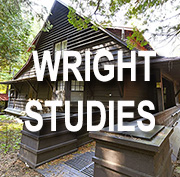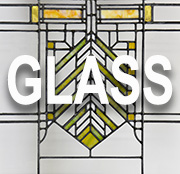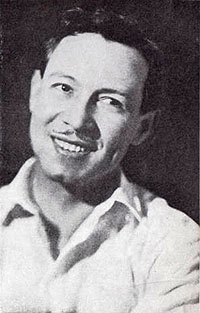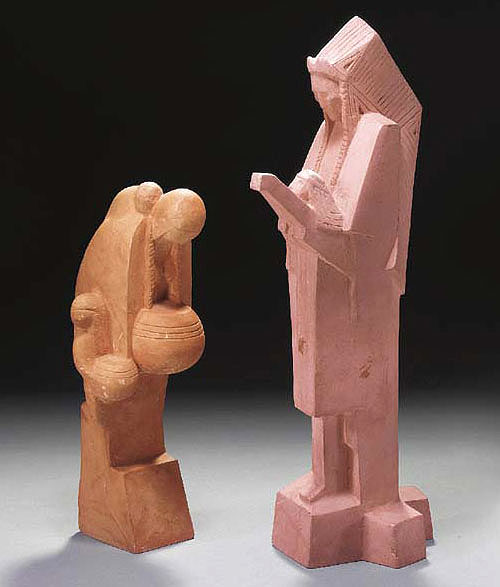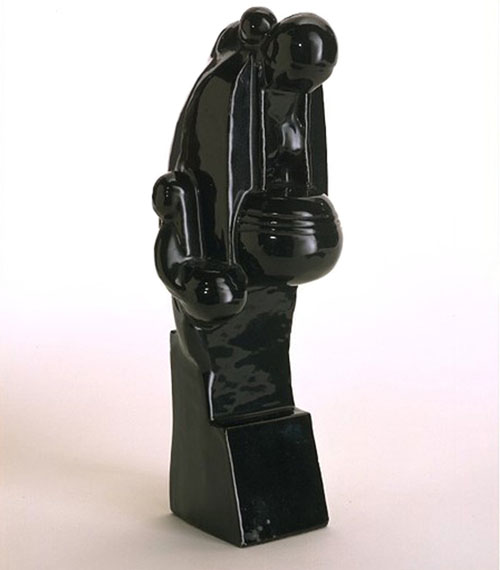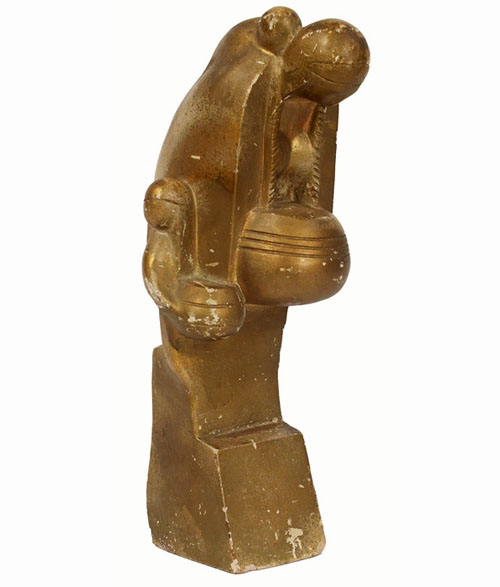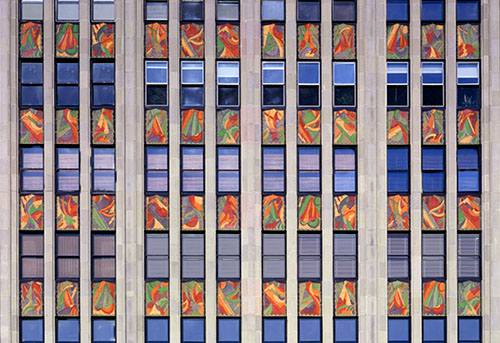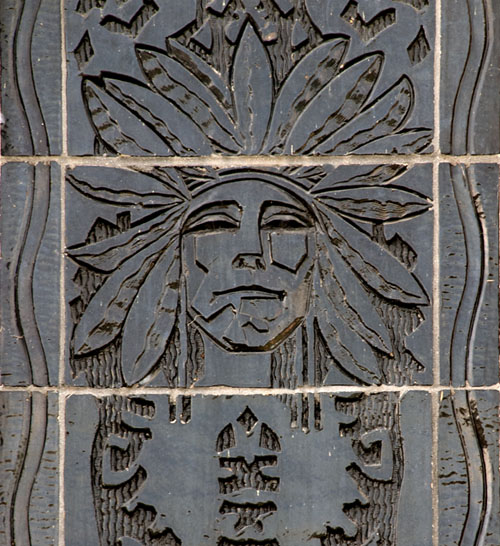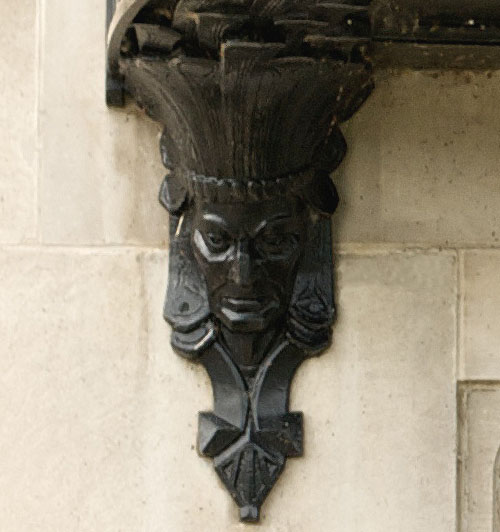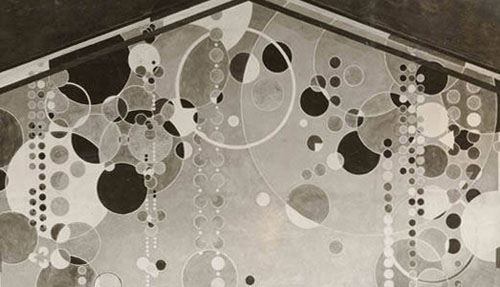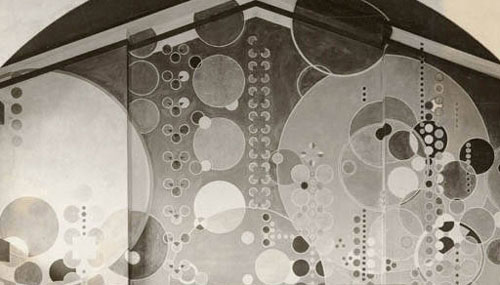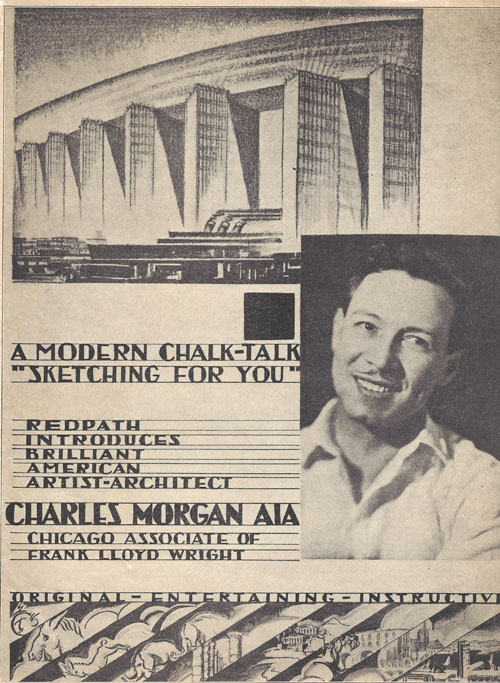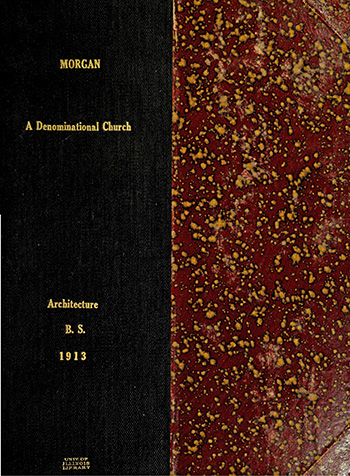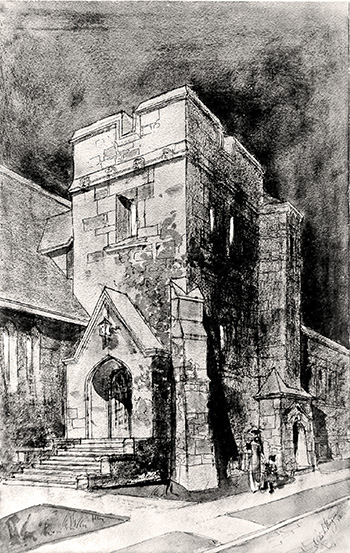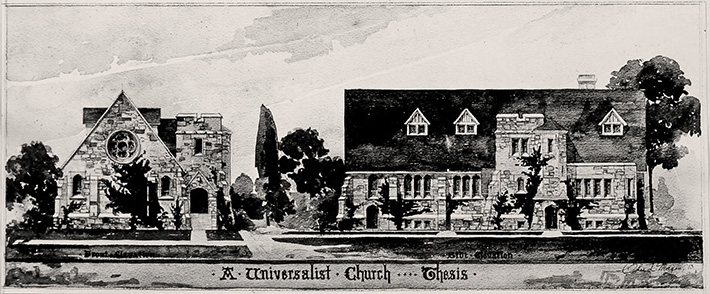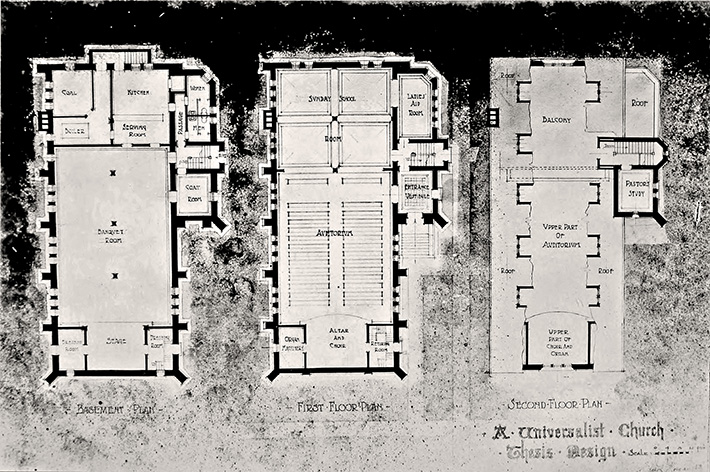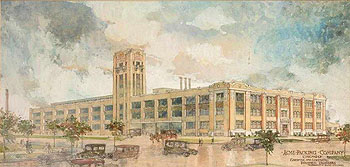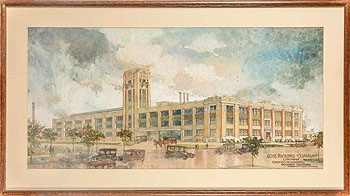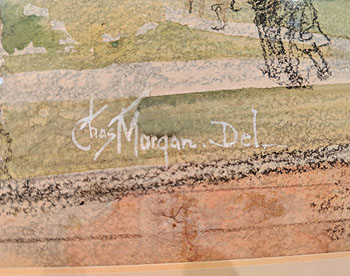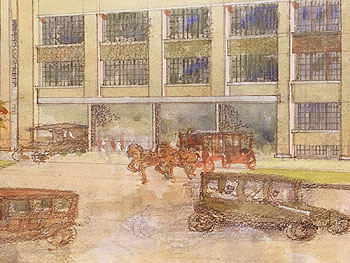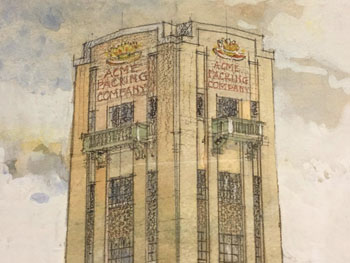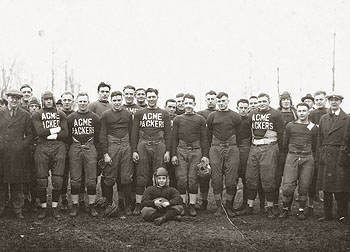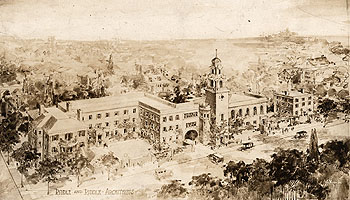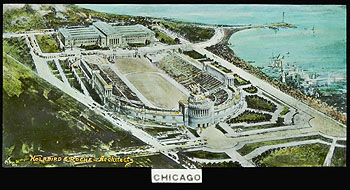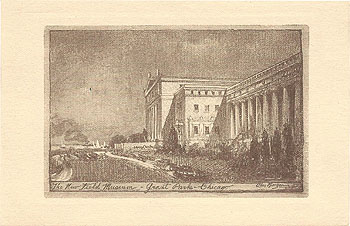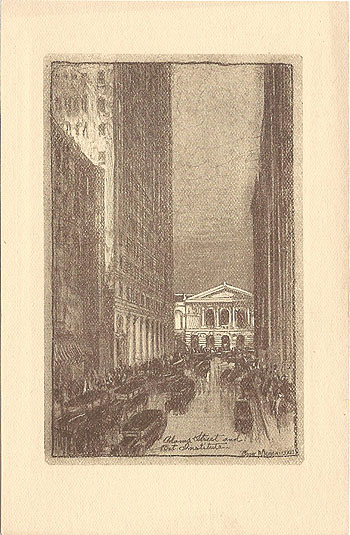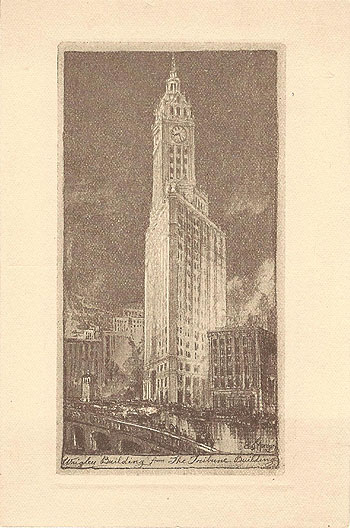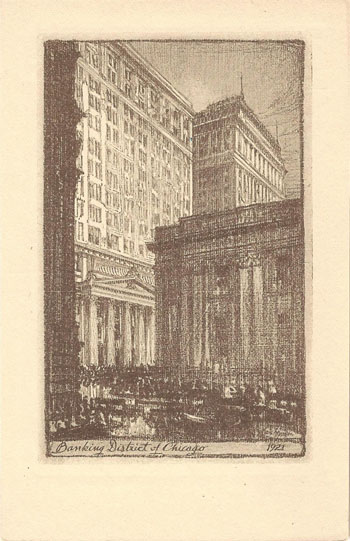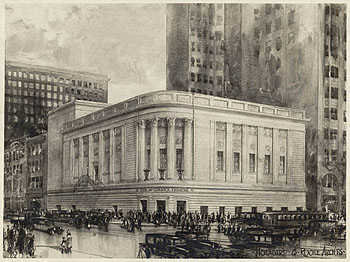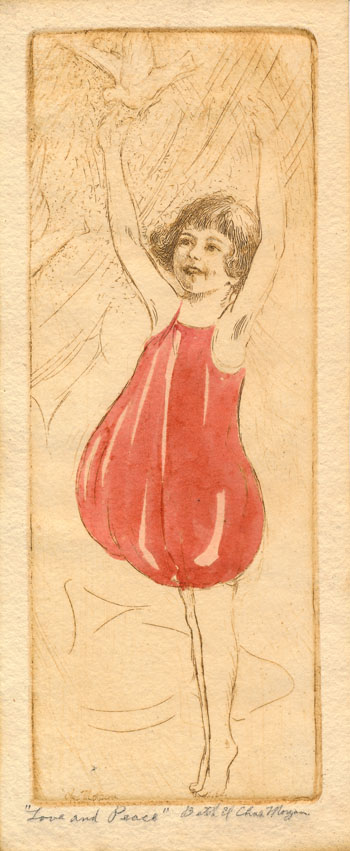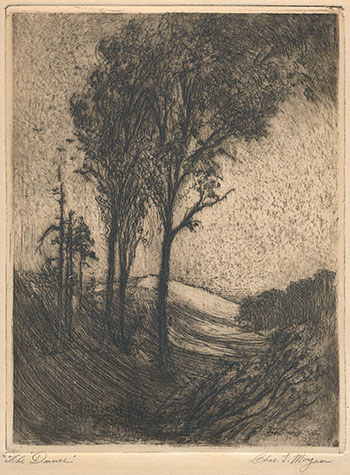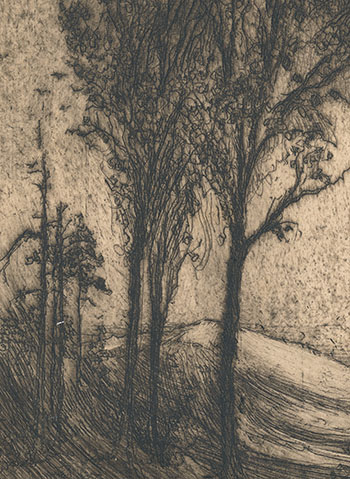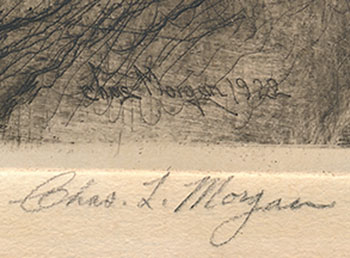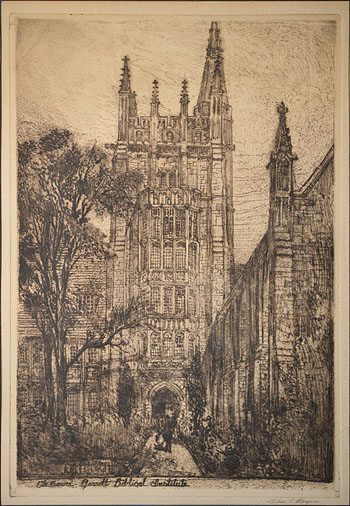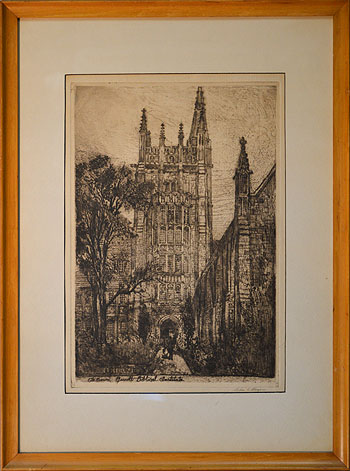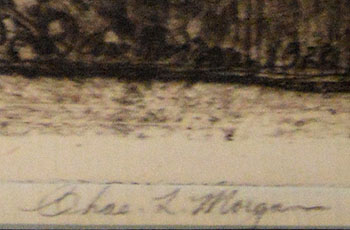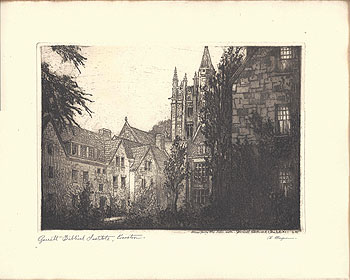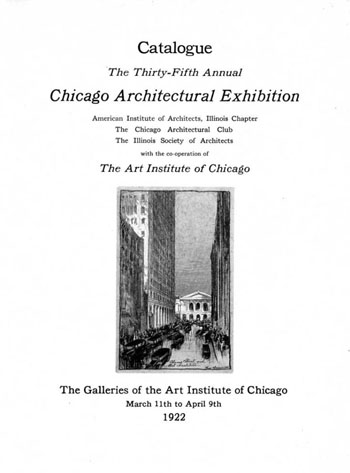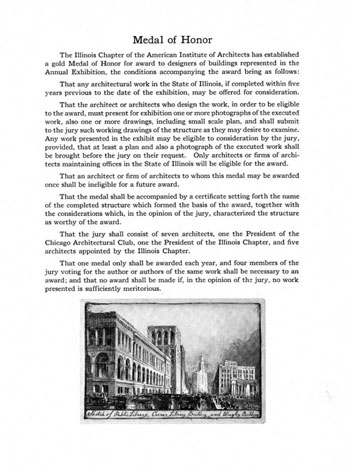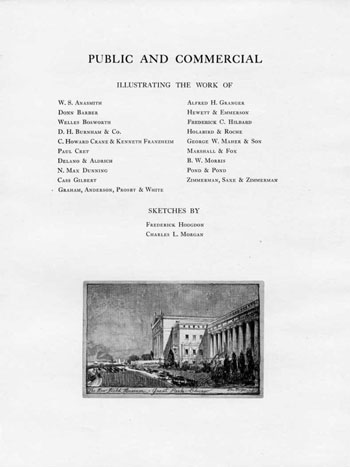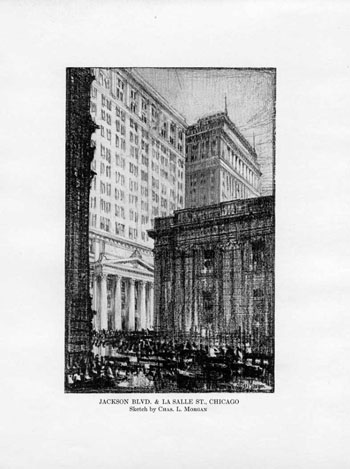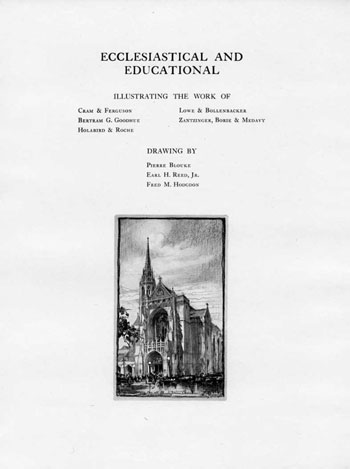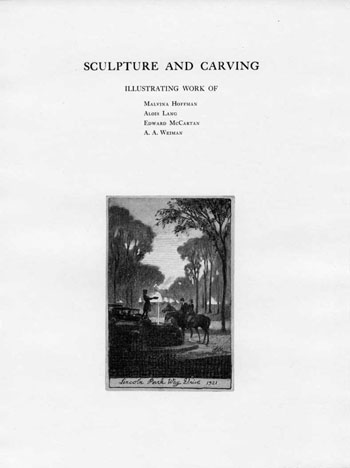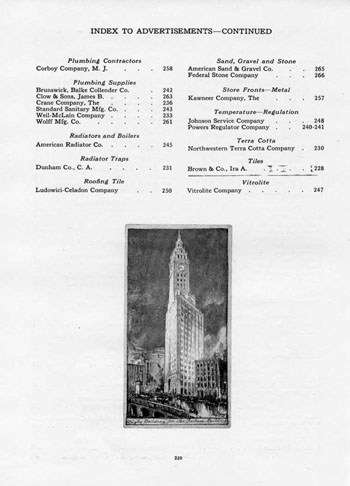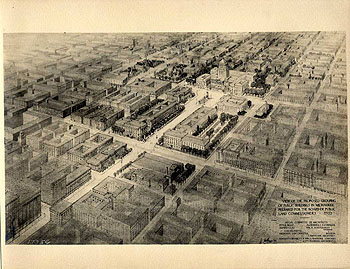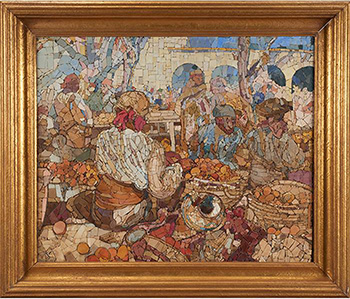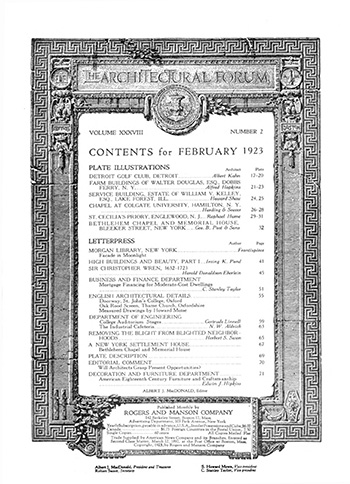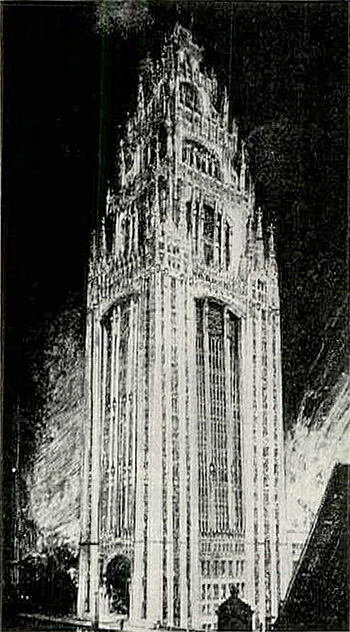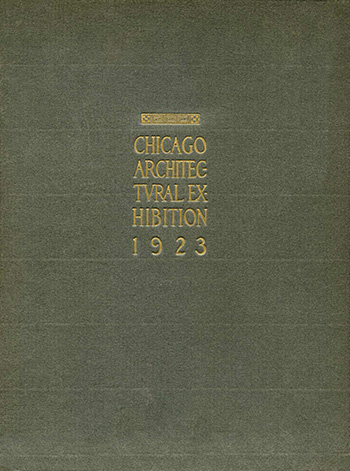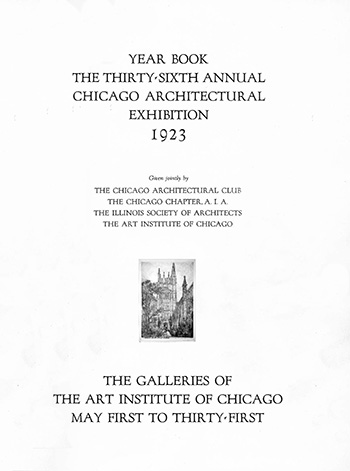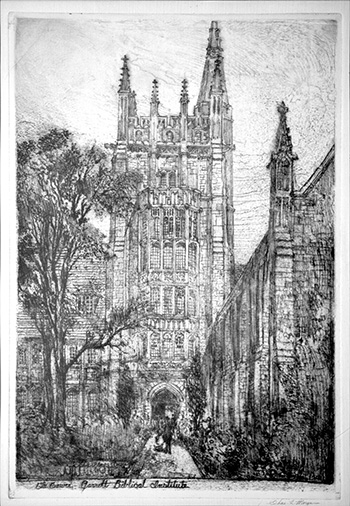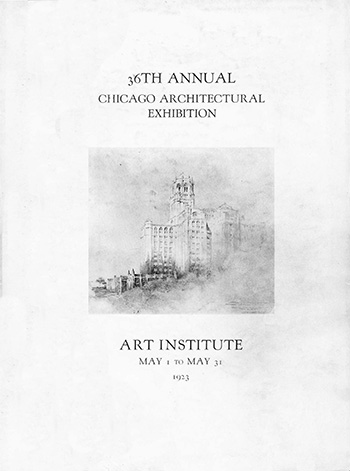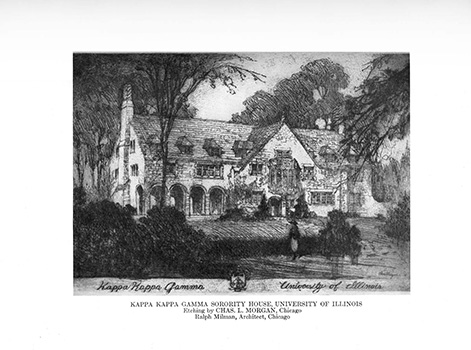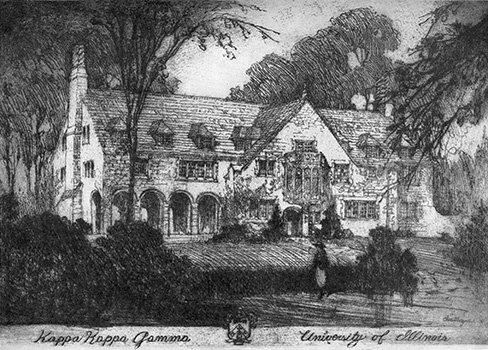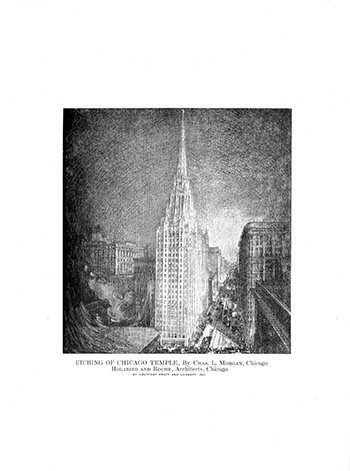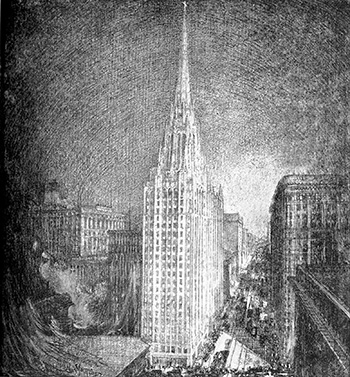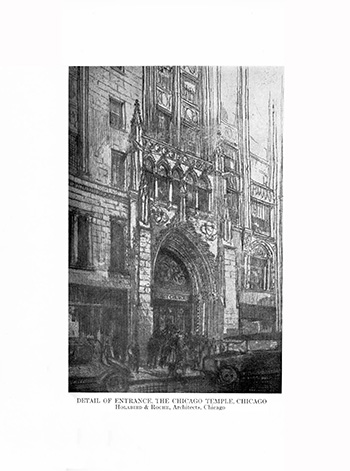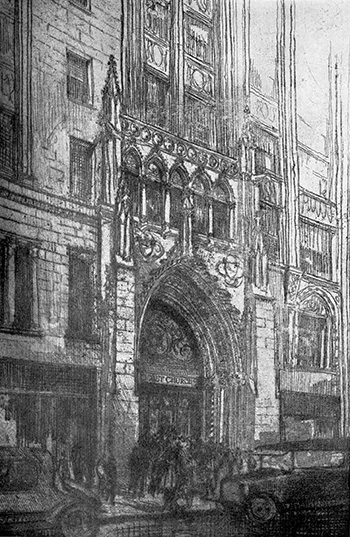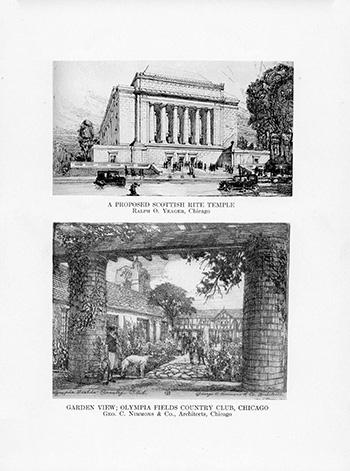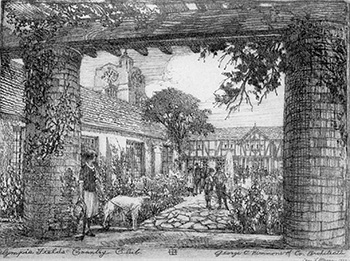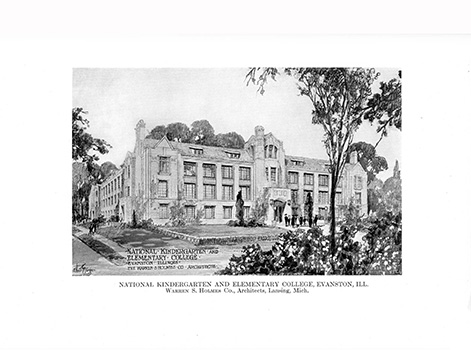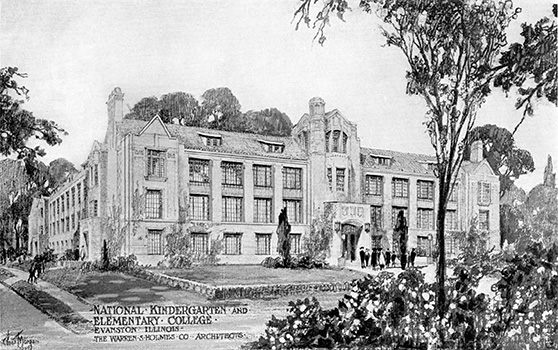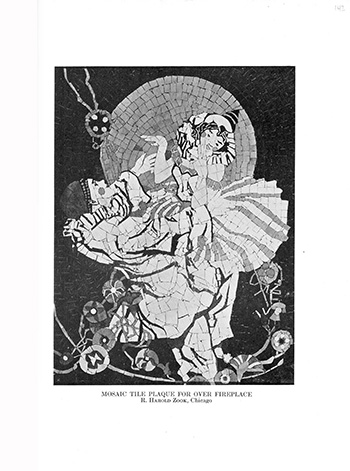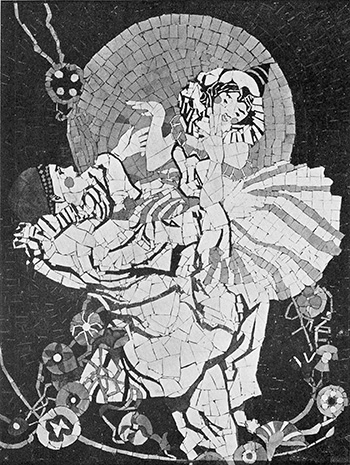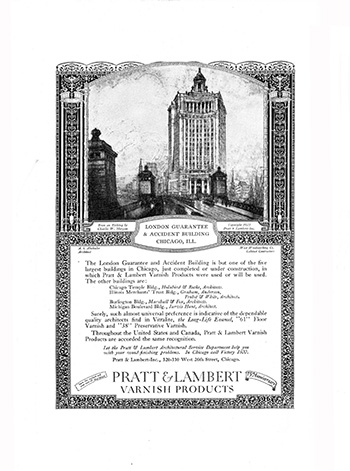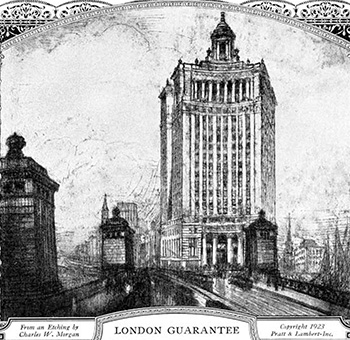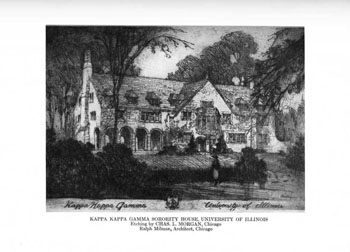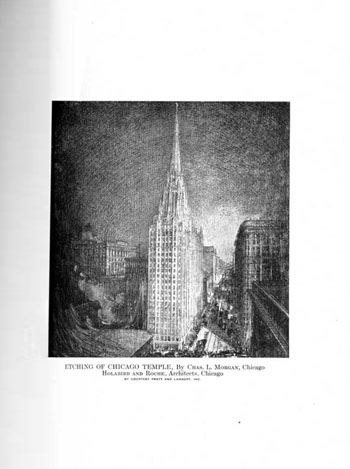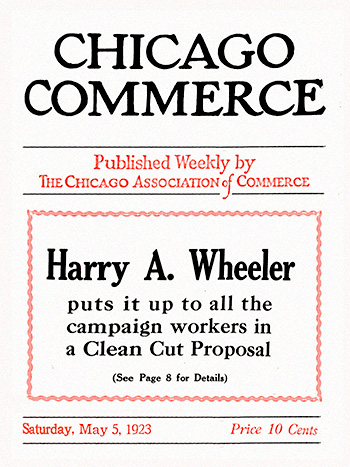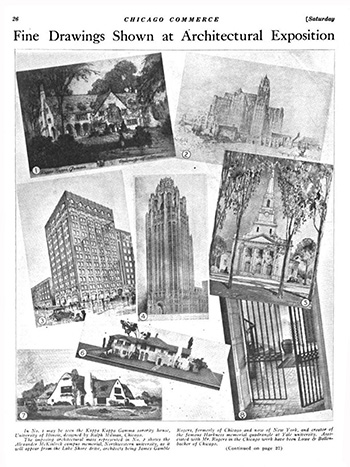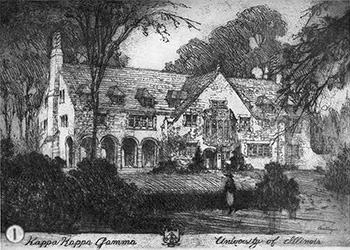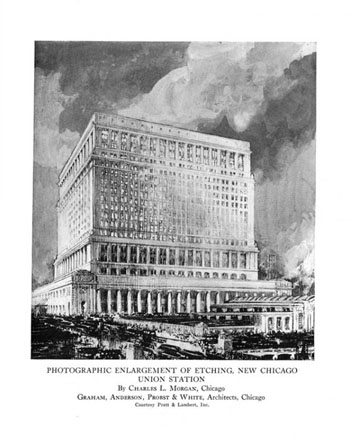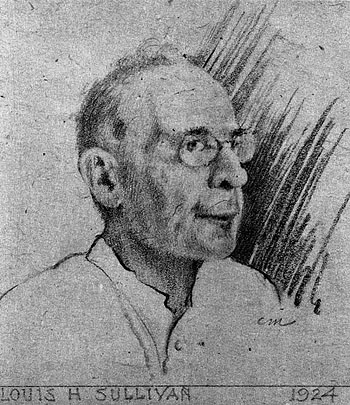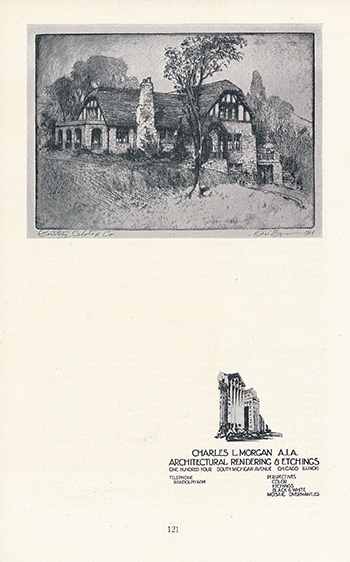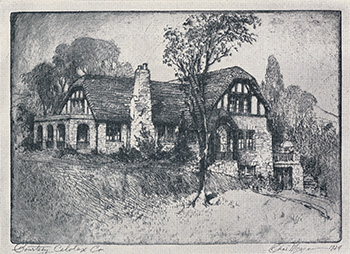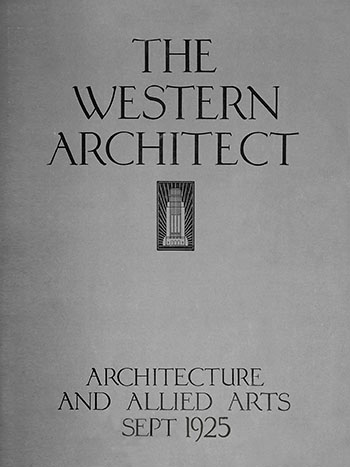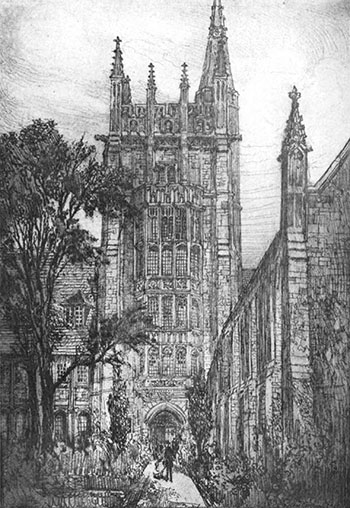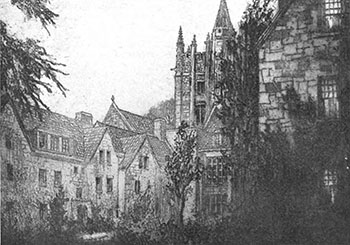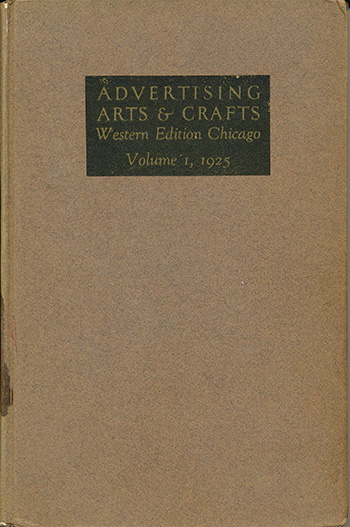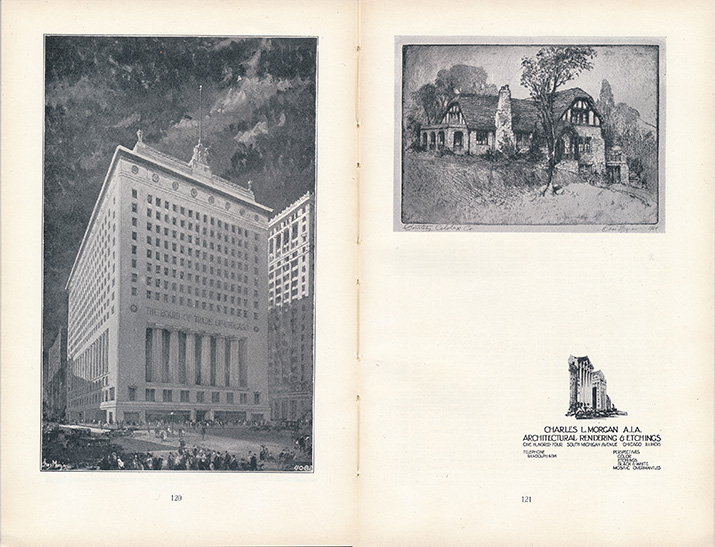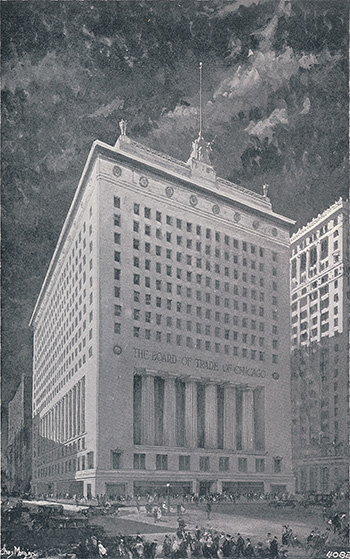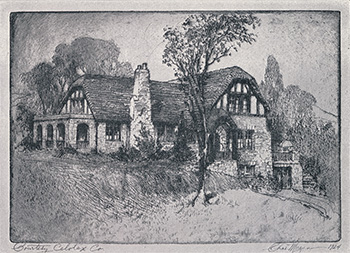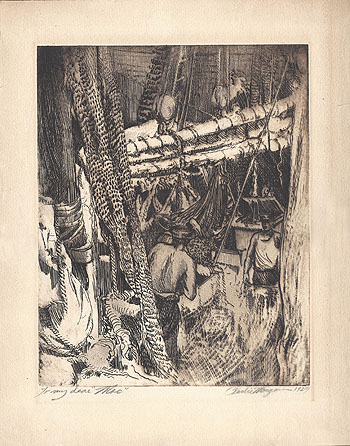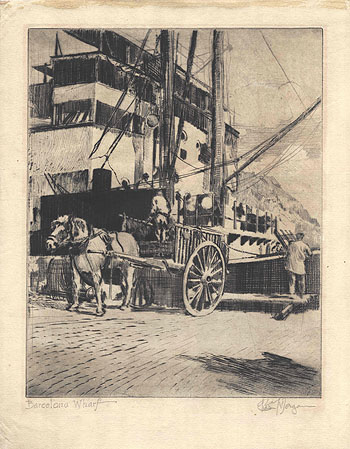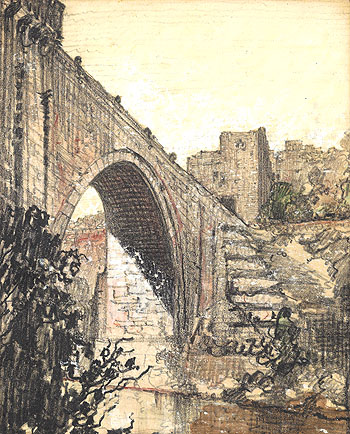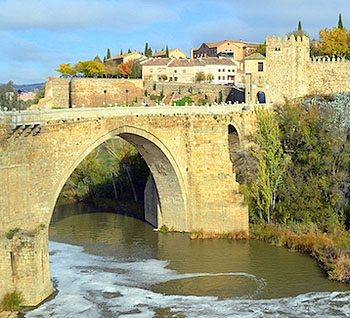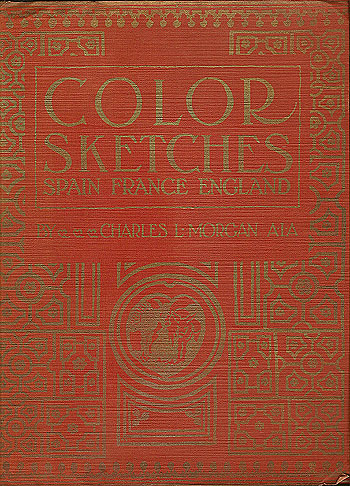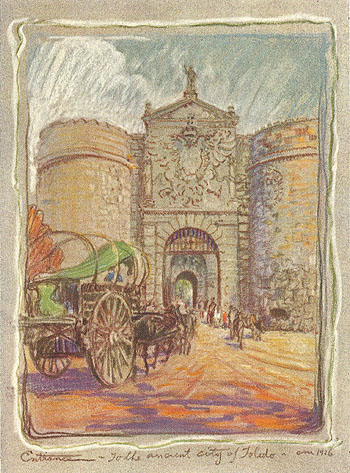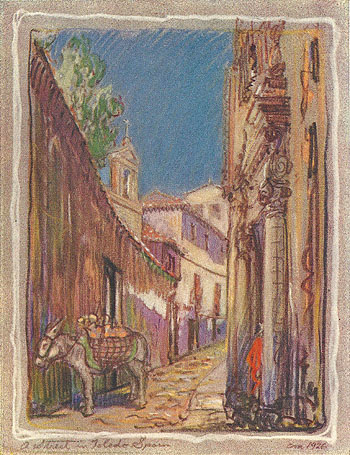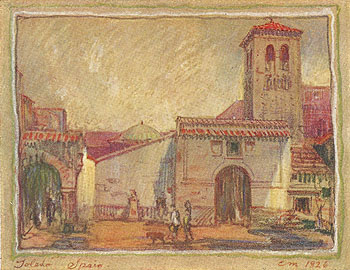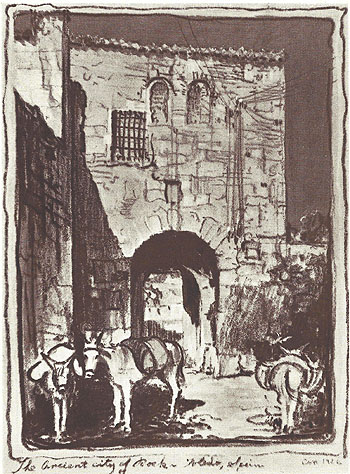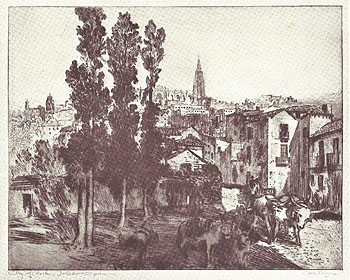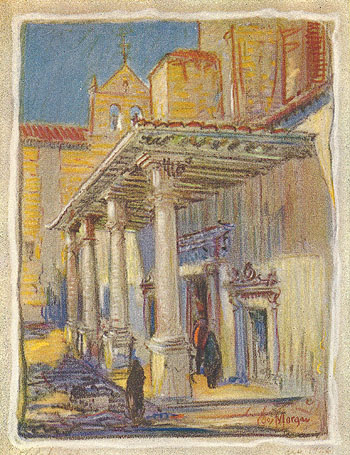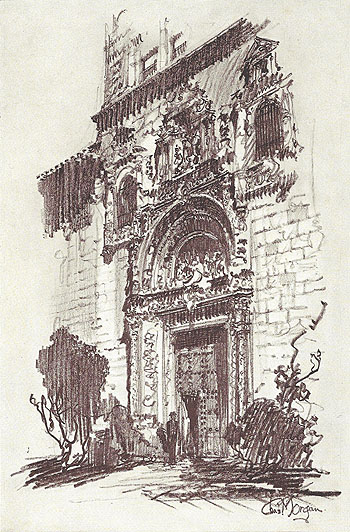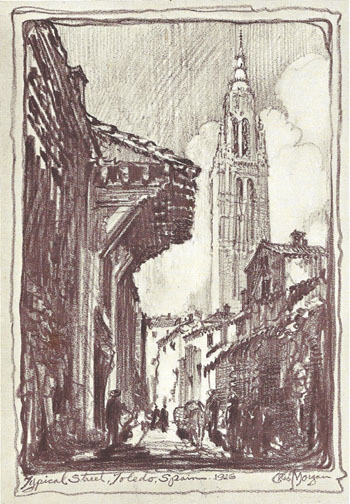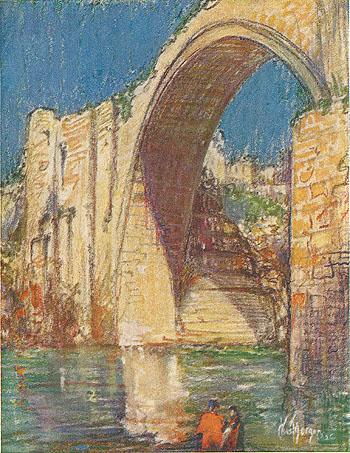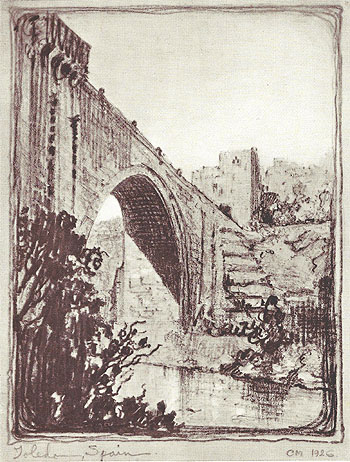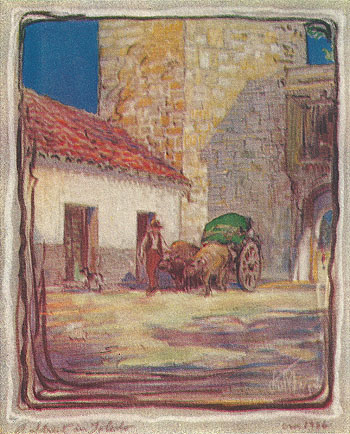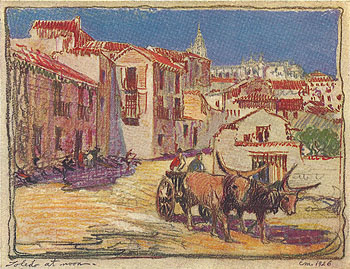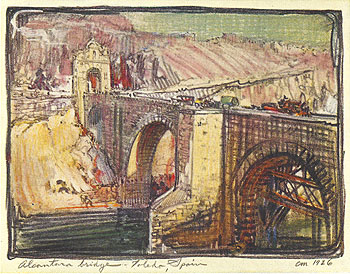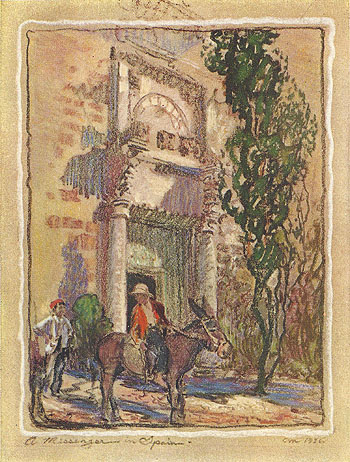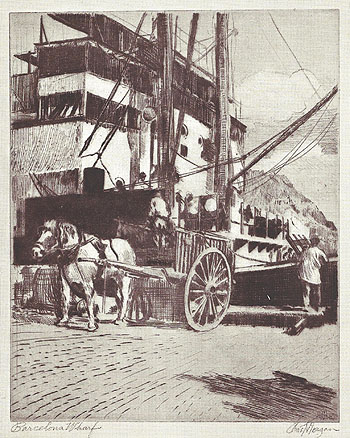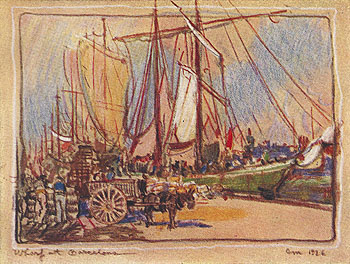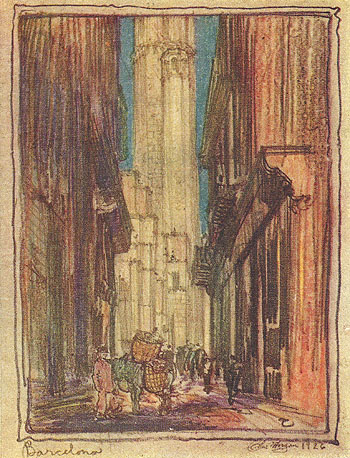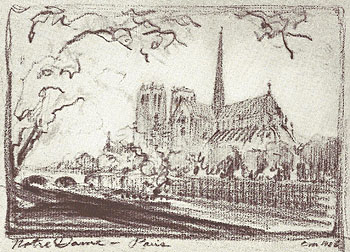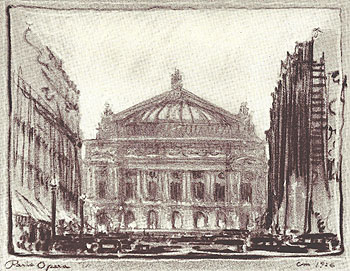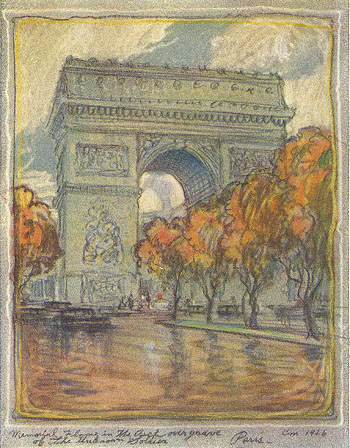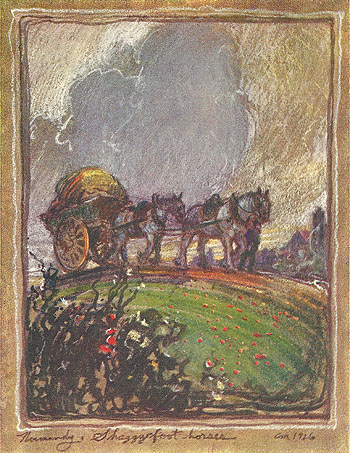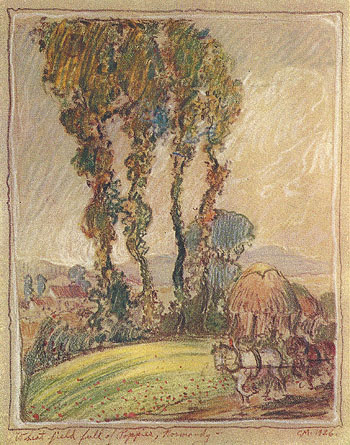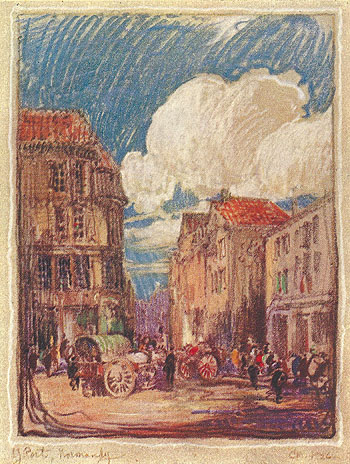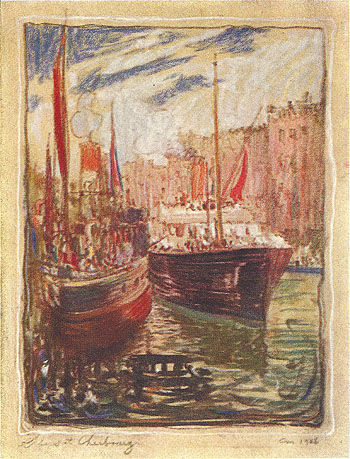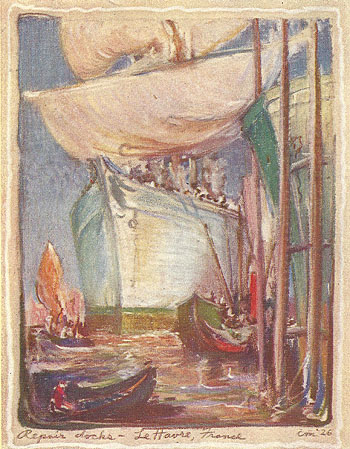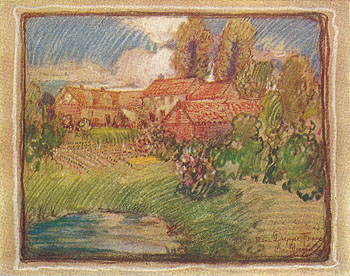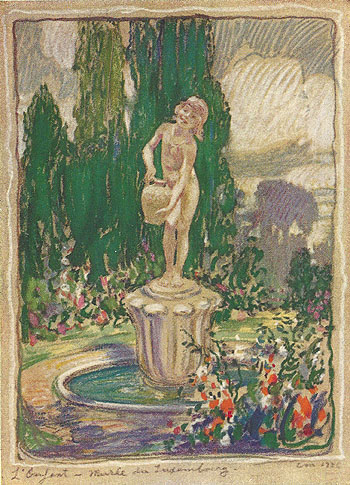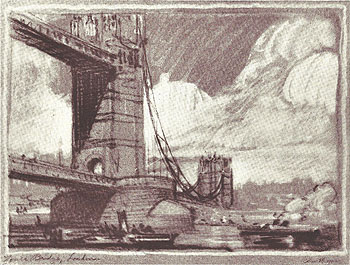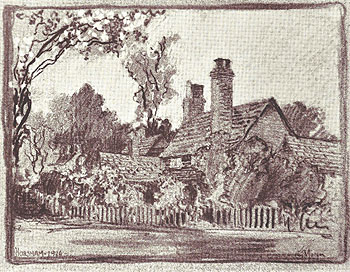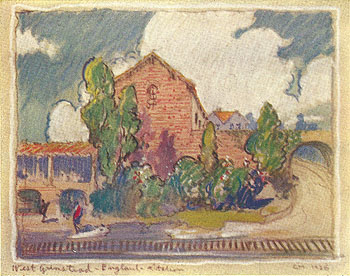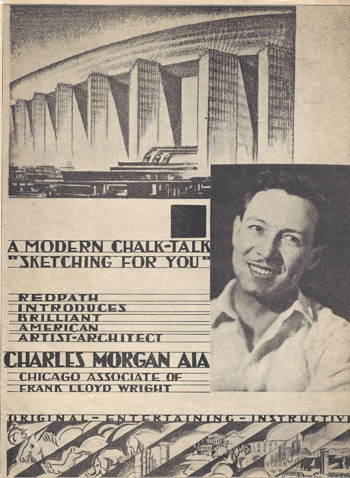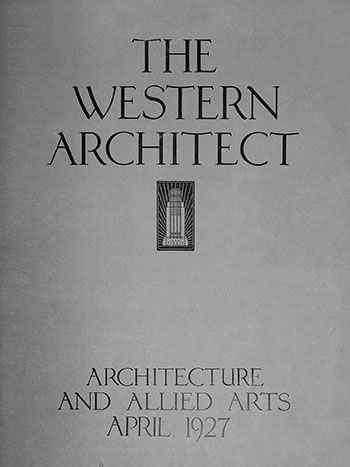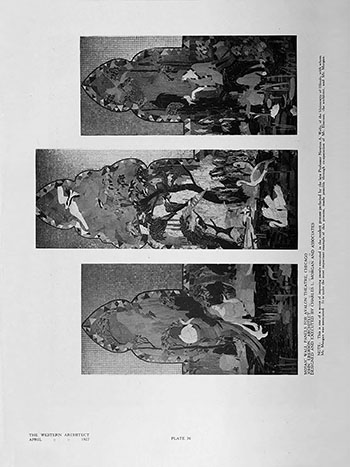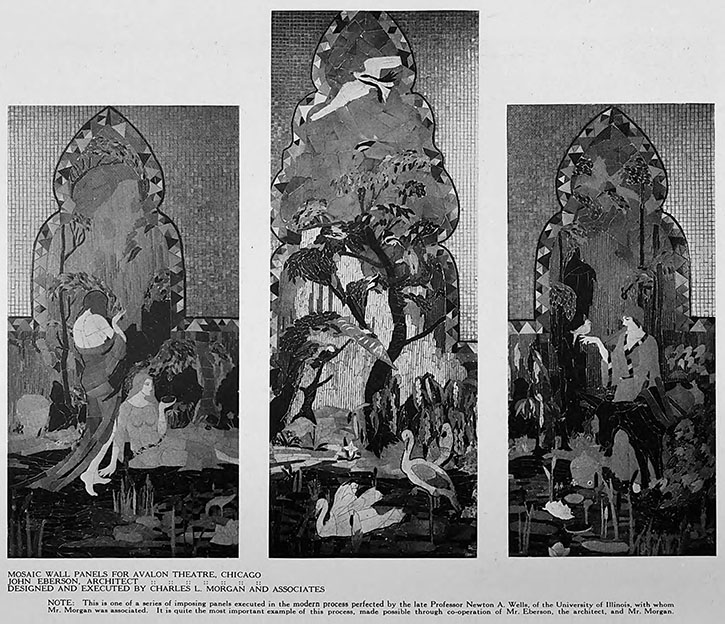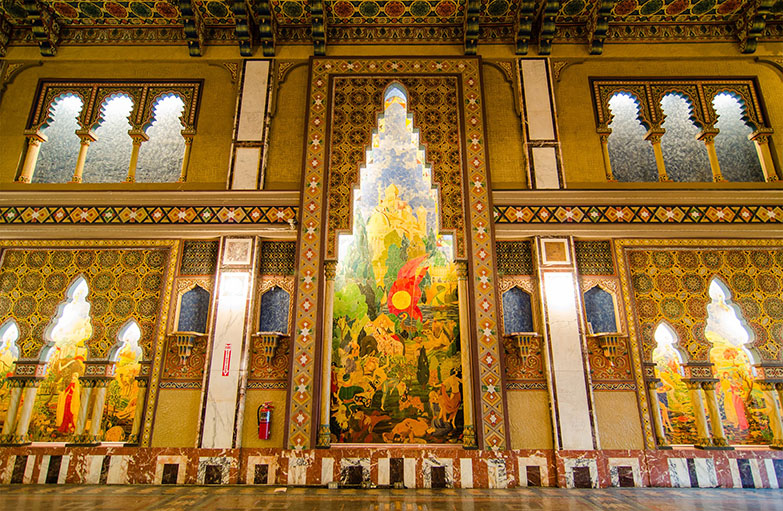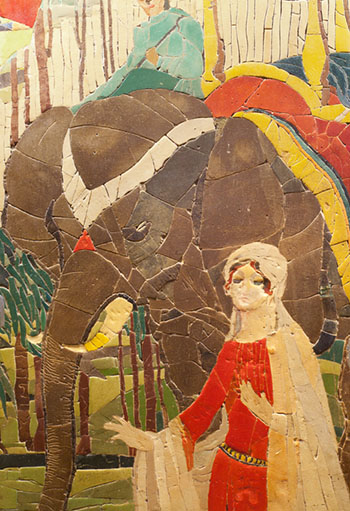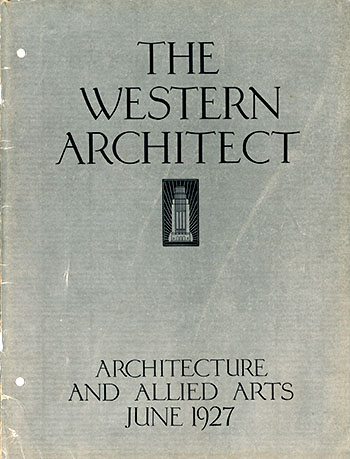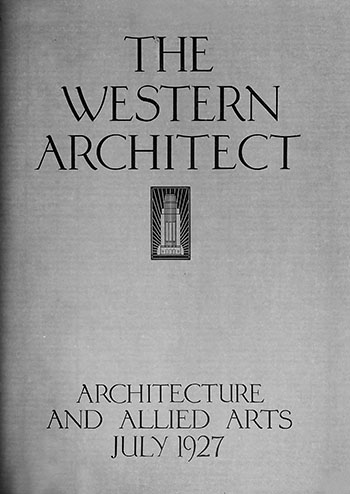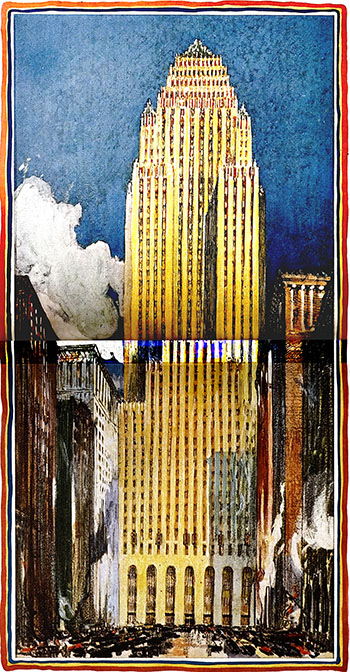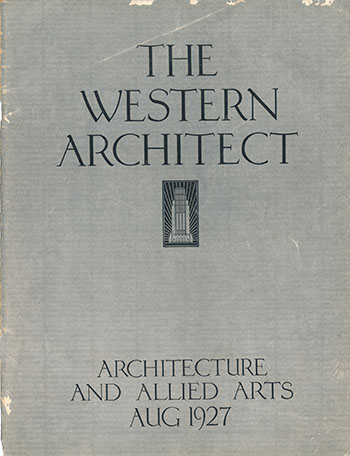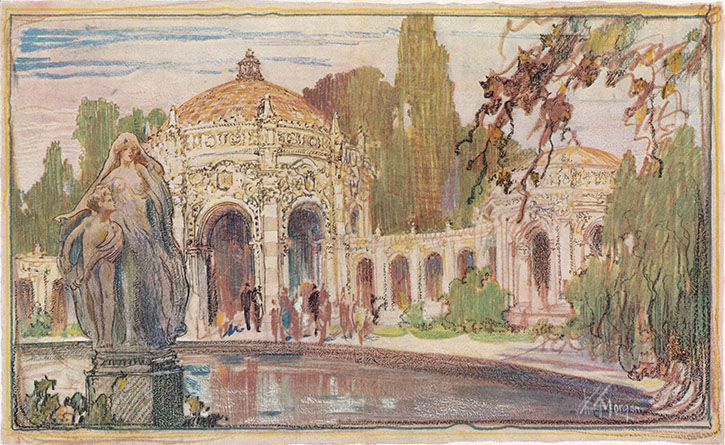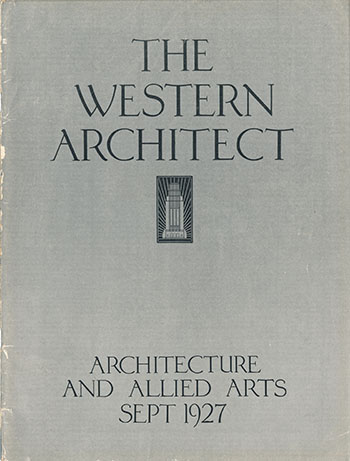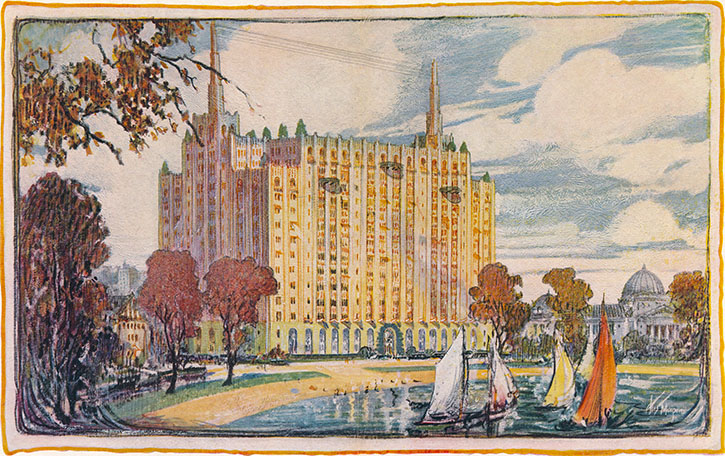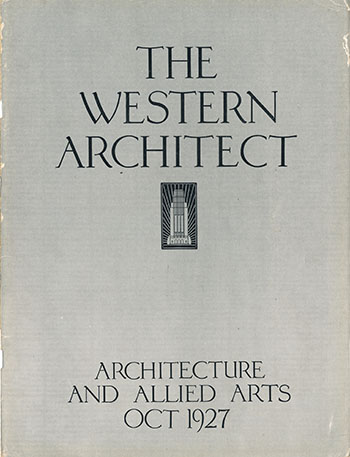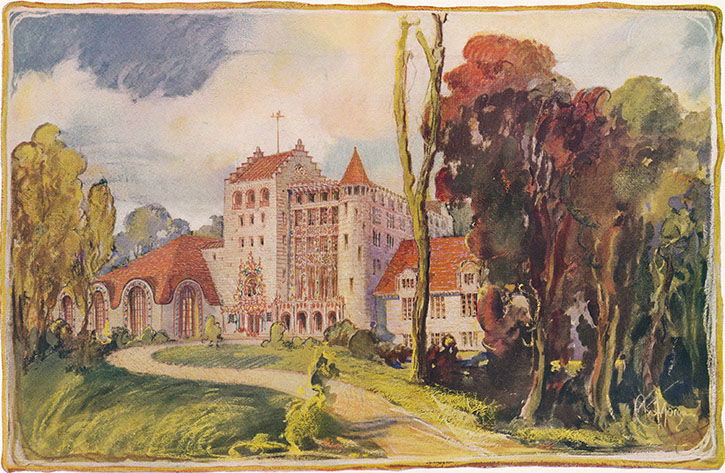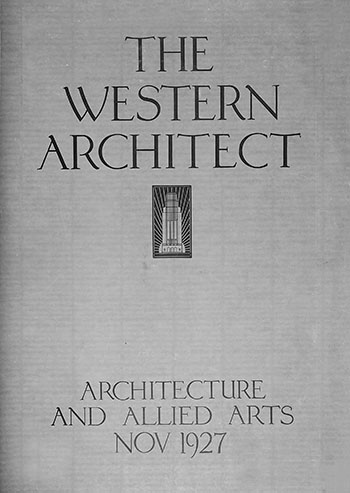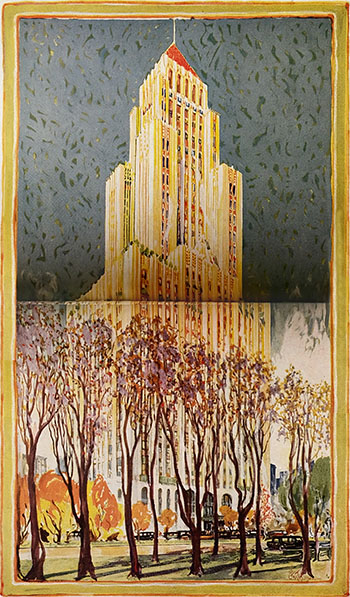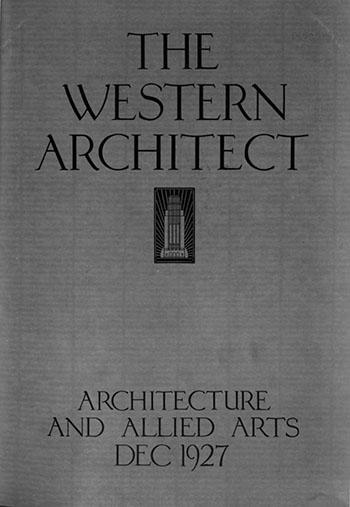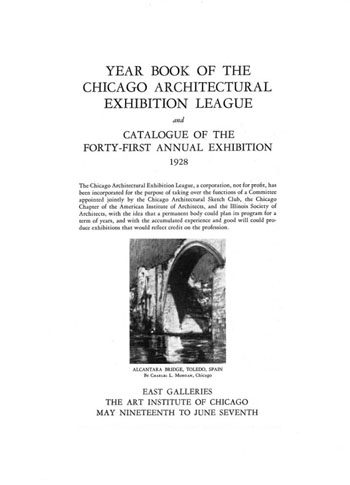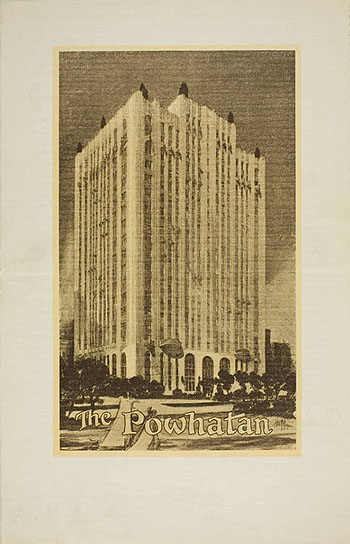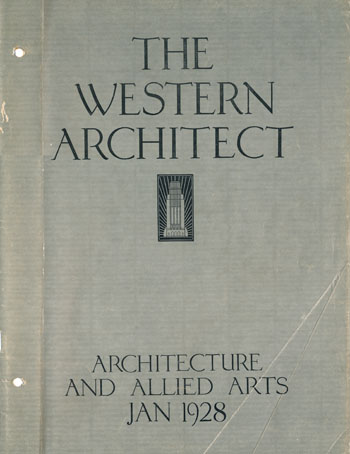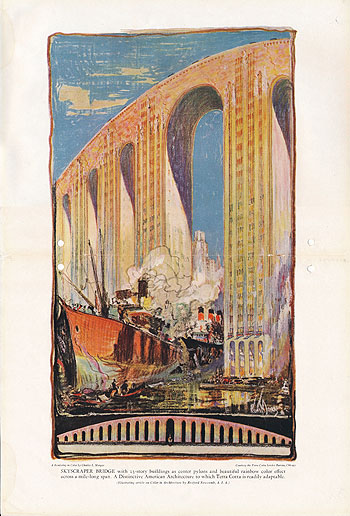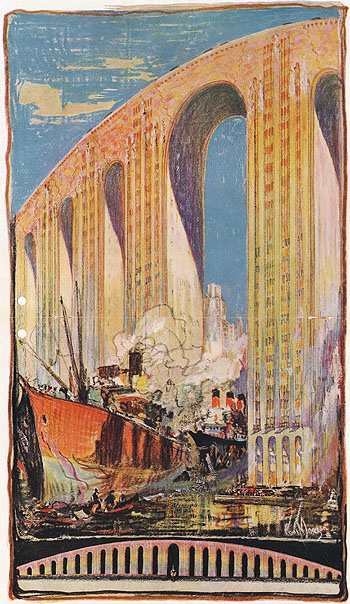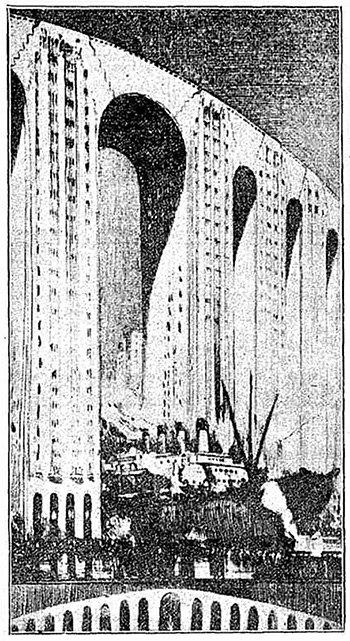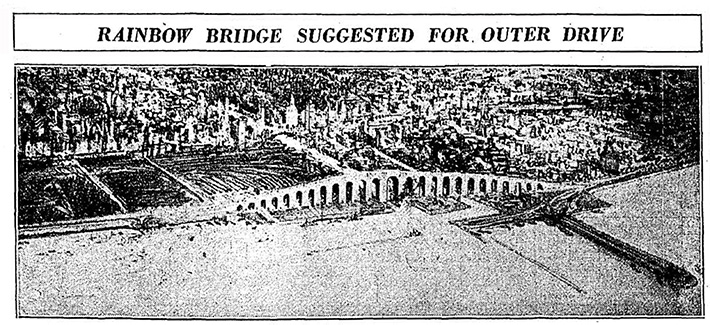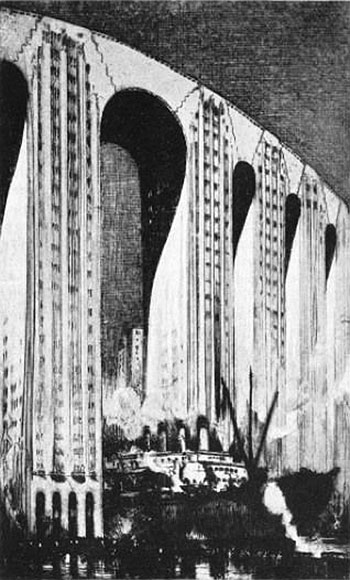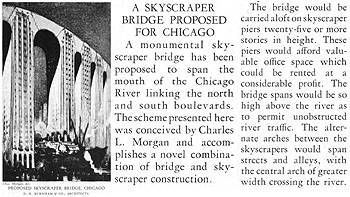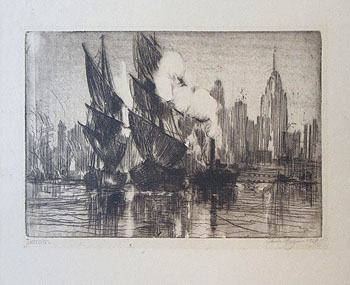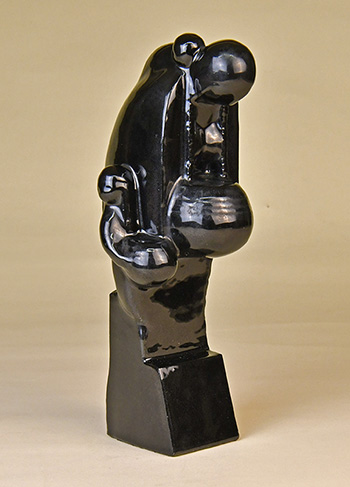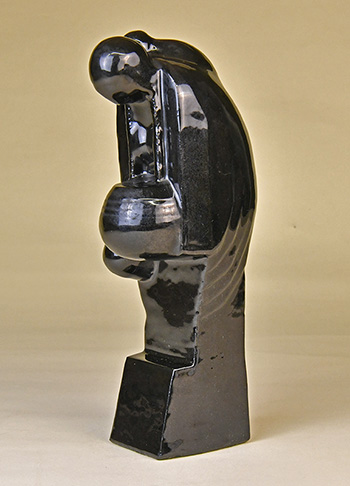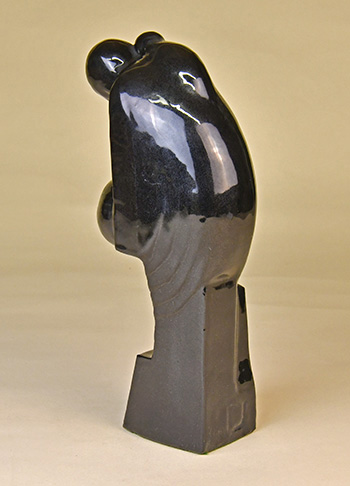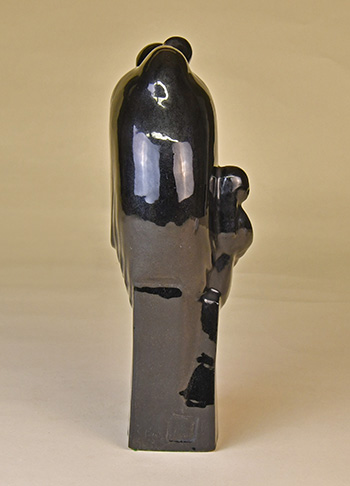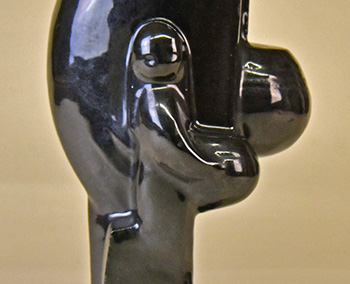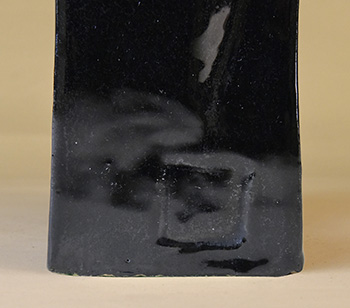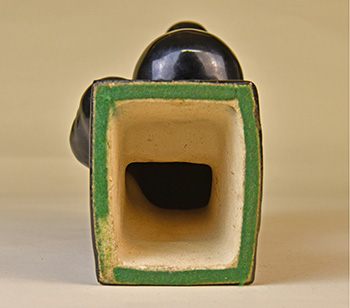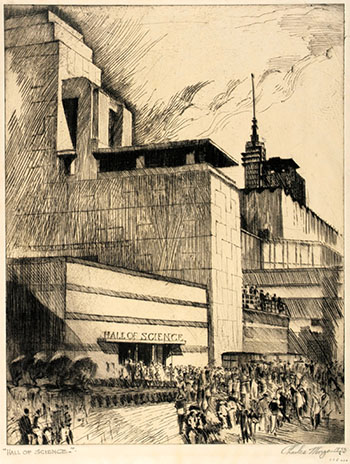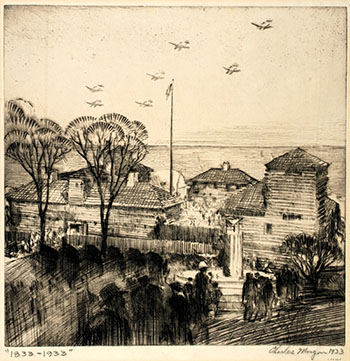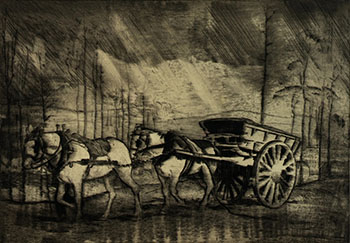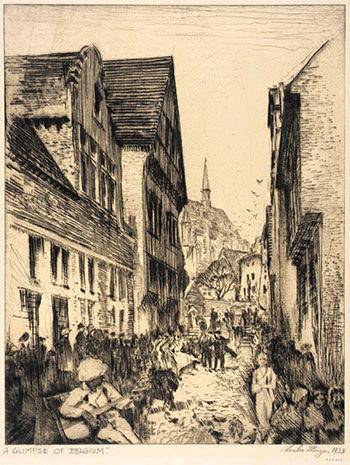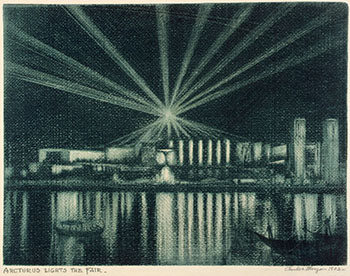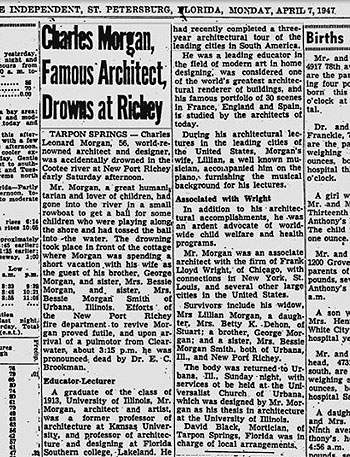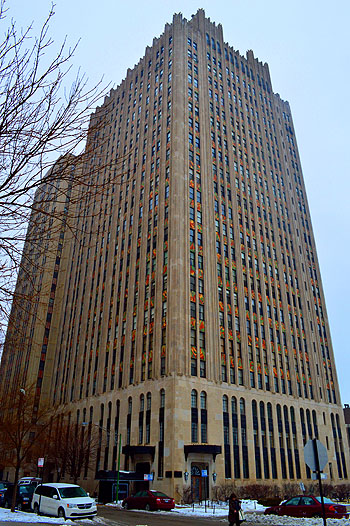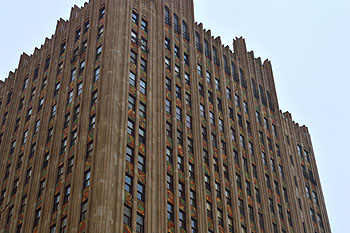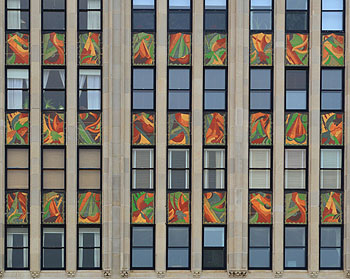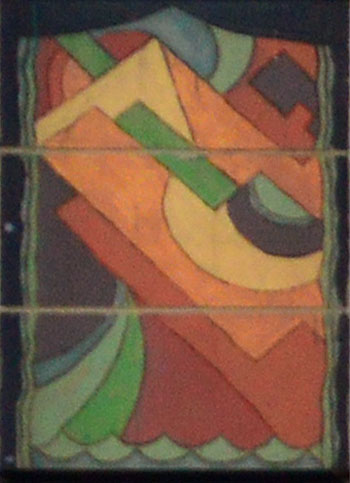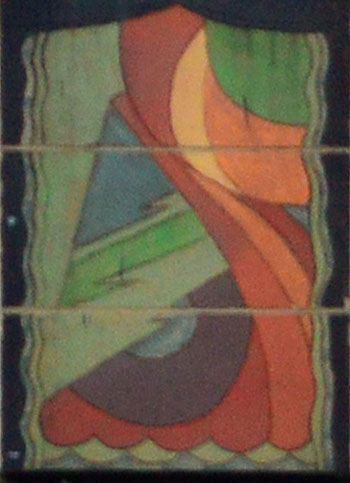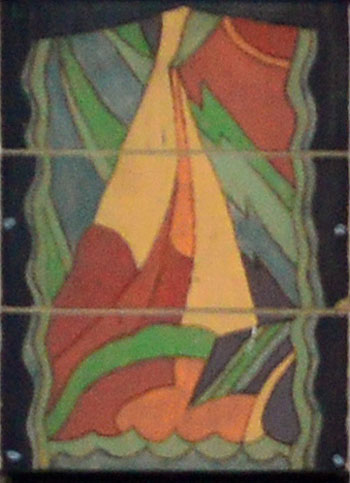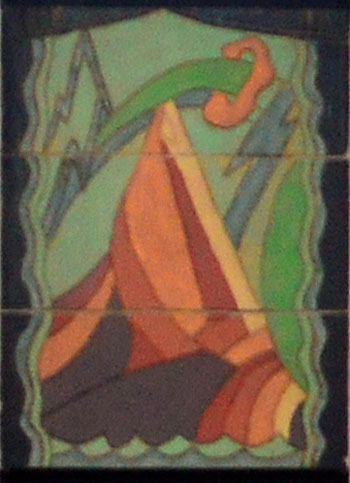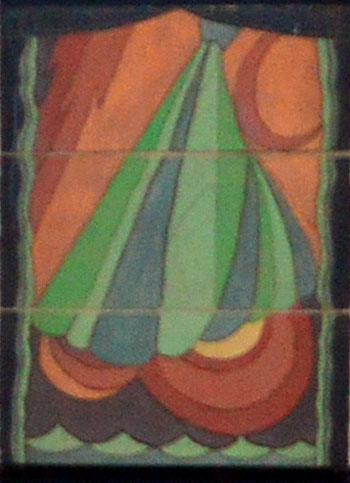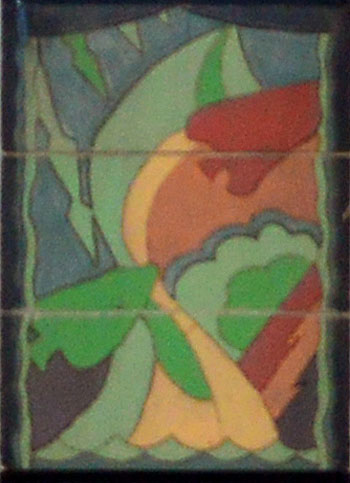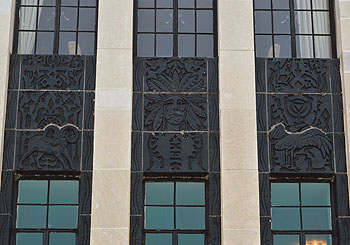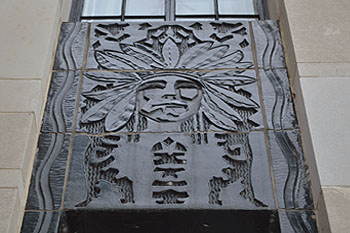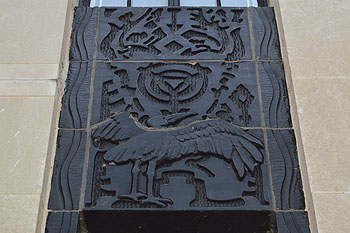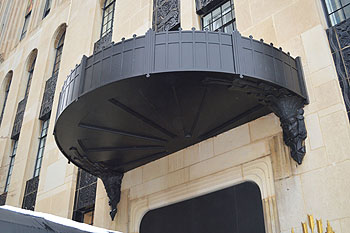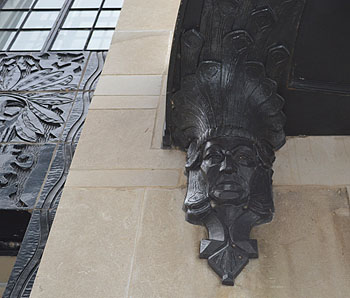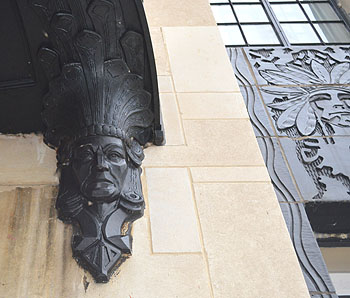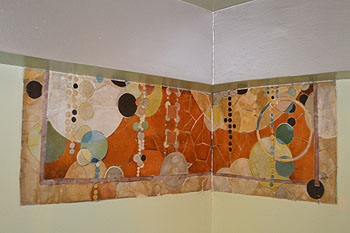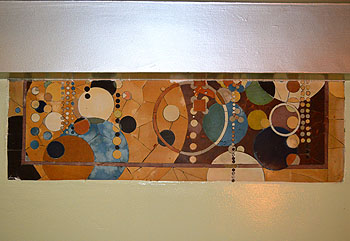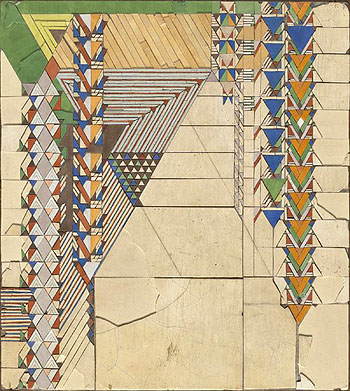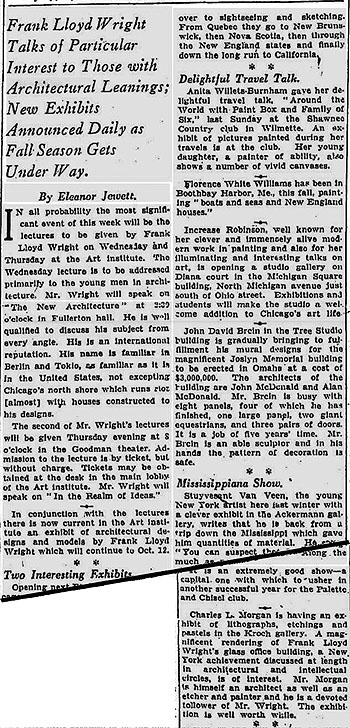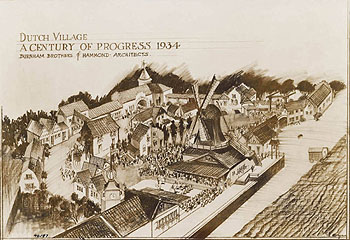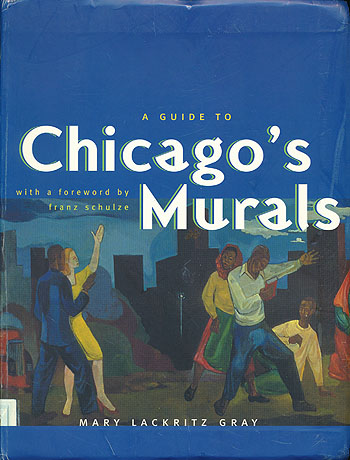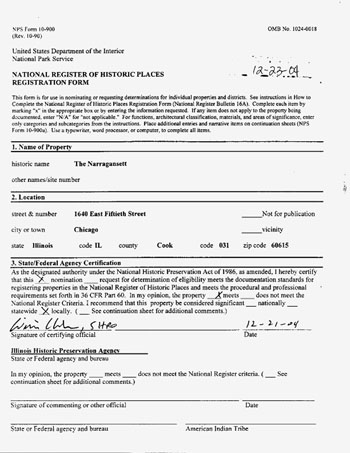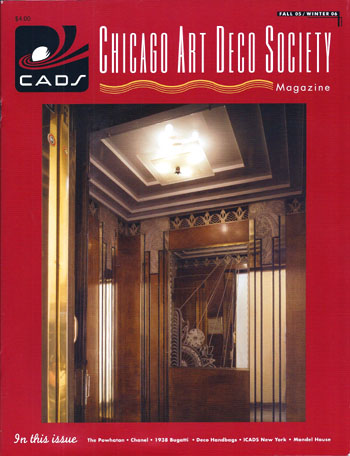
SUPPORT THE
WRIGHT LIBRARY
PROCEEDS FROM EVERY SALE GOES TO SUPPORT THE WRIGHT LIBRARY.
CLICK TO ORDER.
WE PROUDLY SUPPORT THE FRANK LLOYD WRIGHT FOUNDATION
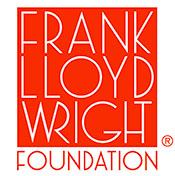
WE PROUDLY SUPPORT THE FRANK LLOYD WRIGHT BUILDING CONSERVANCY
WE PROUDLY SUPPORT FALLINGWATER
AND THE WESTERN PENNSYLVANIA CONSERVANCY

CHARLES L. MORGAN
Items related to Charles L. Morgan Terra-cotta Nakoma and Nakomis sets were created in 1929-1930. Frank Lloyd Wright's project number for the Nakoma Sculptures was 2906, dating it as 1929. Wright's original models were possibly used to create the mold for the terra-cotta sets. Of interest is Charles L. Morgan's involvement to create "a few black sets"ť of the Nakoma and Nakomis in 1930. (Frank Lloyd Wright and Madison, 1990, page 88).
Not only an architect, Charles Leonard Morgan (1890-1947) had a reputation as an excellent artist. Frank Lloyd Wright was working on the National Life Insurance Company project in 1924-1925. Wright sought Morgan's help in preparing a series of perspective drawings for the project.
Due to financial difficulties, Frank Lloyd Wright was incorporated in 1927. He wrote in An Autobiography that "many stories of this incorporation of myself appeared. An idea gained credence that my financial troubles were over. That I could now work with no financial harassments or restrictions..."ť "An Autobiography" (1932, page 294). Donald Johnson writes that Wright tried to establish a series of partnerships with architects in Chicago, New York, Phoenix and Los Angeles. "Frank Lloyd Wright Versus America" 1990, page 11. One of the "Associates,"ť as Wright called them, was Charles L. Morgan. Wright continued in his Autobiography, "Charlie Morgan came forward, as a volunteer, and interested others."ť
In a letter to Morgan on December 12, 1929, Wright clarified the relationship. "I have never entered into any partnership agreement and probably never shall, being totally unfitted for that type of co-operation. I prefer 'association'..."ť Wright details a fee schedule and concludes with, "All contracts should be made and plans too, in the name of Frank Lloyd Wright, Incorporated: Charles Morgan, Chicago Associate."ť "Letters to Architects" (1984, pages 79-80).
Morgan was the associate architect for the Powhatan Building in Chicago, completed in 1929. He was responsible for the colorful mosaics in the lobbies and ballroom, as well as the colorful exterior terra-cotta panels featuring scenes with Native American references. Other American Indian motifs can be found throughout the building. Of particular interest are the mosaic panels in the anteroom between the lobby and the pool. They bear a striking resemblance to the murals in the Tavern of Midway Gardens, designed by Wright in 1913. It's possible Morgan wished to honor Wright's work at the Midway Gardens, which was demolished
Charles L. Morgan, circa 1931.
at the same time the Powhattan Building was receiving its final touches.
During the destruction of Midway Gardens, Wright asked Morgan to assist him with an illustrated essay on Midway Gardens that was planned but never published in the Chicago Daily News.
With the completion of the Powhatan Building in 1929, Wright's association in December, and American Indian motifs and terra-cotta molds freshly on Morgan's mind, his involvement in the Nakoma and Nakomis sets was a natural fit. In a letter to Wright dated December 23, 1930, Morgan discussed finishing the chief and squaw statues in time for Christmas, "and after all these weeks I am having to keep at it all the time to get a few black sets..."ť It was possibly the same black glaze used on the Indian chiefs on the Powhatan Building.
Morgan began making use of his association with Wright, signing his letters as "Charles Morgan, Chicago Associate of Frank Lloyd Wright."ť Possibly due to the Great Depression and a lack of work, Morgan traveled, giving lectures and chalk-talks on modern architecture. One lecture led John Howe to become one of Wright's first apprentices in 1932. (Recollections, 1993, page 124)
As construction began on the Wright-designed Annie Pfeiffer Chapel at Florida Southern College (1938), it was announced on November 26, 1938, in The Southern, the college paper, that "Morgan had arrived at Florida Southern College as the personal representative of Frank Lloyd Wright."ť
On April 5, 1947, Morgan was vacationing in Florida with his wife. Children playing along the shore in front of his brother's cottage accidently kicked a ball into the river. Taking a small rowboat, he attempted to retrieve it for the children, but drowned in the process. Attempts to revive him were futile.
Items related to Charles L. Morgan In a letter to Wright dated December 23, 1930, Morgan talked about finishing the chief and squaw statues in time for Christmas, "and after all these weeks I am having to keep at it all the time to get a few black sets..." (FLW and Madison, 1990, page 88). Possibly the same black glaze used on the Indian Chiefs on the Powhatan Building (Seen below). Nakoma (left) and Nakomis (right). Terra-cotta Figures. 12.25 and 18 inches high. Sold June 13, 2002, Christie's New York. Price realized, $5,975 plus 25% buyers premium. Courtesy of Christie's. Charles L. Morgan wrote in a letter to Frank Lloyd Wright, dated December 23, 1930, that he was finishing a few sets of Nakoma and Nakomis in black, (Frank Lloyd Wright and Madison, 1990, page 88). Terracotta with black glaze, Victoria & Albert Museum, London. Courtesy of the V&A Museum. On March 3, 2008, this Nakoma Sculpture was sold at Treadway Gallery, Chicago. Unglazed terra-cotta painted gold, impressed "FLW" inscription to base. It was given as a gift to the seller in August 1942. Height is 12.25". Price realized $2,800 plus 22% buyers premium. Courtesy of Treadway Gallery. Morgan was the associate architect for the Powhatan Building, Chicago, completed in 1929. He was responsible for the colorful exterior terra-cotta panels featuring scenes with Native American references. Decorative black-glazed terra-cotta panels on the exterior of the Powhatan Building designed by Morgan. He indicated that he was producing a few black sets of the Wright Nakoma and Nakomis. He may have chosen black because of the result of these panels. Decorative black-glazed terra-cotta sculptures on the exterior of the Powhatan Building designed by Morgan. He indicated that he was producing a few black sets of the Wright Nakoma and Nakomis. He may have chosen black because of the result of the panels and this sculpture. Mosaic panel in the anteroom between the lobby and the pool of the Powhatan Building. As the Powhatan was receiving its final touches in 1929, the Midway Gardens was demolished in October 1929. The similarities between the Midway Gardens' murals (below) and Morgan's mosaic panels are striking. Possibly his homage to Wright and the Midway Gardens. Mural on the North end of the Midway Gardens' Tavern. Two matching murals appeared on either end of the Tavern, designed by Wright in 1913. Mural on the South end of the Midway Gardens' Tavern. Two matching murals appeared on either end of the Tavern, designed by Wright in 1913. Morgan began utilizing his association with Wright. Letters were signed "Charles Morgan, Chicago Associate of Frank Lloyd Wright". Possibly due to the depression and lack of work, Morgan travel, giving lectures and chalk-talks on Modern Architecture. (0198.23.0617)
Text by Douglas M. Steiner, Copyright 2012 BACK Charles L. Morgan See additional items related to Charles L. Morgan Date: 1913
Title: A Denominational Church. Thesis For Degree of Bachelor of Science In Architecture. College of Engineering, University of Illinois. (Digital Edition) (Published by Charles Leonard Morgan)
Author: Morgan, Charles Leonard
Description: A Denominational Church.
If there is any particular class of "buildings that should, be really artistic it is certainly the churches. And if we take it for a settled fact that art is "the beautiful way of doing things", it is not hard to trace back through the ages and find that art is inspired through the church. When the church lost its power in the sixteenth century art received a most disastrous blow. The church shall continue to inspire persons to nobler lives and surely it should be a beautiful place itself; so we want to try and find what it is that makes a church beautiful without the lavishing of labor that was characteristic of the Middle Ages.
With what I have read on the subject, it seems to me that the most important point to remember is that a church is a church, the house of God, and cannot be classed with any other kind of buildings. If a man wants to build a store and has money enough only to make it of wood he is at liberty to do so, but it is a rather general opinion that it would be even better to worship a while in a tent rather than to erect a house for the worship of God out of planks, such a perishable material. However, before we consider material, except for this one point, it is well to notice that the lav/ of simplicity is the most attractive feature of the most successful designs. This is most evident in the small country churches of England, and since that...
Includes three illustrations. Perspective, Elevations and plans. Courtesu of the University of Illinois Library. (Digital Edition)
Size: 8 x 11
Pages: Pp 18
S#: 0120.40.0126
Includes three illustrations. Perspective, Elevations and plans.
A) Perspective illustration of main entrance. Text hand written lower right: “Chas L. Morgan 13.”
B) Front and side elevations. Text: “Frnt
Elevation. Side Elevation. A Universalist
Church . . . . Thesis." Hand written lower
right: “Chas L. Morgan 13.”
C) Plans. Text: “Basement Plan. First
Floor Plan. Second Floor Plan. A
Universalist Church Thesis Design.”
Hand written lower right: “Chas L.
Morgan 13.”
Date: 1917
Title: Acme Packing Company Original Watercolor by Charles L. Morgan, 1917.
Description: Charles L. Morgan (1890-1947) had a reputation as an excellent artist as well as being an architect. Frank Lloyd Wright was working on the National Life Insurance Company project in 1924-1925. Wright sought Morgan's help in preparing a series of perspective drawings for the project. In 1925, an illustration or a home Morgan designed was exhibited at the Chicago Architectural Exhibition League. In 1926, the League awarded Morgan second place in the "Dickey" Architectural Competition. His illustrations were published in a number of Chicago Architectural Exhibitions. C. E. Martin Formed the Acme Packing Company in 1909. It was announced on November 16, 1910 in the Chicago Tribune that the company was breaking ground on a new $50,000 packing plant which "is to be the most modern and complete for the manufacture of canned meats in the country." It was announced that the "Acme Packing Company has acquired 3 acres at Western Avenue and Forty fifth Street and will improve at once with a modern packing house for special lines," The Way-Bill, August. 1916. Ice and Refrigeration, February 1917 reported the same, adding: "...they will build a new packing house to cost about $250,000. Plans for buildings to cover 150x300 feet of ground are being prepared by Gardner & Lindberg..." On April 5, 1917, the Chicago Tribune also announced that a building permit was also issued for a three-story brick storage facility at 2222-24 S. Lasalle Street for the Acme Packing Company: by Gardner & Lindberg Architects. The Indian Packing company filed incorporation papers on Nov. 14, 1916 in Green Bay, Wisconsin. They also were "organized under the laws of Delaware, July 22 1919 and has been known as a large and very aggressive advertiser of Council Brand canned meats and other canned food products and has large and thoroughly modern packing plants at Green Bay, Wisconsin, Providence, RI and Greenwood, Indiana." The American Food Journal, January, 1921, p.21. Although both companies where well know in their day, their legacies have nothing to do with canned meats. In 1919 and 1920, the Indian Packing Company sponsored the first two seasons of a football team and named it the "Packers." Curly Lambeau was working as a receiving clerk for Indian Packing at the time. The American Food Journal, January, 1921, p.21 also announced that Acme and Indian were consolidating under the Acme name with plants in Chicago, Green Bay and Providence, RI. During the 1921 season, the team wore "Acme Packers" jerseys. The rest is history for the Green Bay Packers. Original watercolor and pencil on paper. Not dated. Illustration includes early automobiles and one horse-drawn delivery "truck." Signage on tower: "Acme Packing Company." Signed lower left: "Chas Morgan. Del." Text bottom right: "Acme Packing Company, Chicago. Gardner and Lindberg, Industrial Engineers. Marquette Bldg, Chicago."
Size: Image size: 40" x 18.5." Framed: 47" x 25.5"
S#: 0138.23.0218
Acme Packers 1921.Date: 1917
Title: Chicago Theological Seminary By Charles L. Morgan, 1917.
Description: Charles L. Morgan (1890-1947) was an architect, and had a reputation as an excellent artist. Frank Lloyd Wright was working on the National Life Insurance Company project in 1924-1925. Wright sought Morgan's help in preparing a series of perspective drawings for the project. In 1925, an illustration or a home Morgan designed was exhibited at the Chicago Architectural Exhibition League. In 1926, the League awarded Morgan second place in the "Dickey" Architectural Competition. Text lower left: "Riddle and Riddle Architects." Signed lower right: "Chas Morgan, 1917." Courtesy of the University of Chicago Library.
Size: 10 x 6 Color photograph,
S#: 0138.19.1017Date: 1917
Title: Soldier's Field, Illustrated by Charles L. Morgan, 1919.
Description: Aerial view of Soldier's Field looking North, including the Field Museum. Lake Michigan is to the right. Charles L. Morgan (1890-1947) had a reputation as an excellent artist as well as being an architect. Frank Lloyd Wright was working on the National Life Insurance Company project in 1924-1925. Wright sought Morgan's help in preparing a series of perspective drawings for the project. Signed lower left: "Chas Morgan. Del." Text bottom left: Holabird & Roche - Architects." Courtesy of the Art Institute of Chicago.
Size: 10 x 5.5 Color photograph.
S#: 0138.24.0319Date: 1921
Title: Charles L. Morgan set of 6 post cards 1921.
Description: 1) "The New Field Museum - Grant Park - Chicago. Chase Morgan." 2) "Adams Street and Art Institute. Chas Morgan 1921." 3) "Wrigley Building from The Tribune Building. Chas Morgan." 4) "Banking District of Chicago. Chas Morgan 1921." 5) "University Club and Monroe Building from Grant Park. Chas Morgan." 6) "Lincoln Park Way Drive, 1921. Chas Morgan." Verso, six cards: "Post Card. Architectural Sketch Studio, Chicago, Illinois. Series of Chicago."
Size: Six Post Cards, 3.6 x 5.5.
S#: 0144.10.1116 (A-F)
Above: 1) "The New Field Museum - Grant Park - Chicago. Chase Morgan."
Left: 2) "Adams Street and Art Institute. Chas Morgan 1921."
Right: 3) "Wrigley Building from The Tribune Building. Chas Morgan."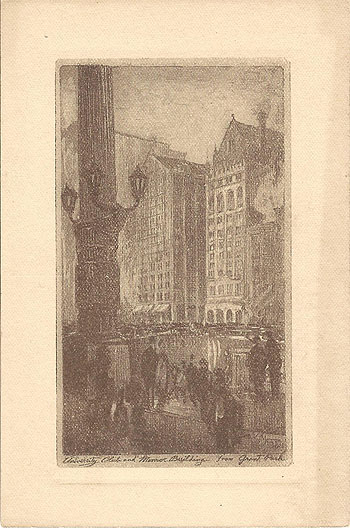
Left: 4) "Banking District of Chicago. Chas Morgan 1921."
Right: 5) "University Club and Monroe Building from Grant Park. Chas Morgan."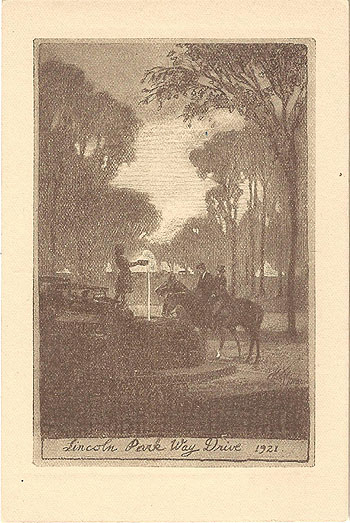
6) "Lincoln Park Way Drive, 1921. Chas Morgan." Verso, six cards: "Post Card. Architectural Sketch Studio, Chicago, Illinois. Series of Chicago."Date: 1921
Title: Apollo Theatre Architectural Illustration by Charles L. Morgan, 1921.
Description: Perspective view of the exterior, 31-45 W. Randolph St., Chicago, Illinois. Designed by Holabird & Roche, Architects. Charles L. Morgan (1890-1947) had a reputation as an excellent artist as well as being an architect. Frank Lloyd Wright was working on the National Life Insurance Company project in 1924-1925. Wright sought Morgan's help in preparing a series of perspective drawings for the project. The Apollo Theatre was constructed in 1921 as a live theater venue, later used as a cinema and renamed the United Artists Theatre. It was demolished in 1989. Text on the face of the theatre: "The McCormick Theatre." Signed lower right: "Chas Morgan." Text bottom right: "Holabird & Roche, Archts." Courtesy of the Art Institute of Chicago.
Size: 10 x 8 B&W photograph.
S#: 0144.14.021Date: Circa 1921
Title: Charles L. Morgan Etching "Love and Peace" Circa 1921.
Description: Illustration of a young girl, slight smile on her face, standing on her tip toes, arms raised, dove settling on her right hand. Signed in plate: "Chas Morgan." Hand written: "Love and Peace." Bet_ _ Chas Morgan. Not dated. It has been suggested that this was Morgan's daughter. Etching pulled from a copper plate and hand colored, watercolor.
Size: Paper size: 3.5 x 8.5. Plate size: 2.75 x 7.7,
S#: 0144.15.0720Date: 1922
Title: "The Dunes." Illustrated by Charles L. Morgan, 1922.
Description: Original etching from a copper plate. View of an unnamed dunes. A few sparse wind weathered trees grow in the foreground. A small forest encroaches on the dunes in the distance. Charles L. Morgan (1890-1947) was an architect, and had a reputation as an excellent artist. Frank Lloyd Wright was working on the National Life Insurance Company project in 1924-1925. Wright sought Morgan's help in preparing a series of perspective drawings for the project. Signed in the plate lower right: "Chase Morgan, 1922." Hand written in pencil, lower left: "The Dunes." Singed in pencil lower right: "Chase L. Morgan." Etching pulled from a copper plate and hand colored, watercolor.
Size: Sheet size: 10.75 x 14. Plate size: 7.5 x 9.75. Frame: 13.25 x 16.25
S#: 0147.29.1123Date: 1922
Title: The Tower, Garrett Biblical Institute Etching by Charles L. Morgan, 1922.
Description: Morgan was an associate of Frank Lloyd Wright. View of the Tower from the Northwest. Large etching. Garrett Biblical Institute, Evanston, Illinois, established in 1853 through a gift by Mrs. Eliza Garrett, was the first Methodist Seminary in the Midwest. It was formed largely by the same church people who founded Northwestern University. Text in plate, lower left below etching: "The Tower - Garrett Biblical Institute." Sighed in the plate, within the etching, lower right: "Chas Morgan 1922." Signed in pencil: "Chas L. Morgan."
Size: Original 12.125 x 17.75 Etching from a copper plate. Framed, 20.25 x 27.3.
S#: 0172.44.0618Date: Circa 1922
Title: Garrett Biblical Institute Etching by Charles L. Morgan, Undated, Circa 1922.
Description: Garrett Biblical Institute, Evanston, Illinois, established in 1853 through a gift by Mrs. Eliza Garrett, was the first Methodist Seminary in the Midwest. It was formed largely by the same church people who founded Northwestern University. Text lower right in the etching: "View from the lake side - Garrett Biblical Institute. C. M." Signed in pencil: "Garrett Biblical Institute, Evanston. Ch. Morgan." Note: Morgan presented a copy of the etching to Dr. James Henry Breasted, and hand-signed it: "Garrett Biblical Institute, Evanston - To Dr. Breasted. Chas Morgan." Etching is in the archives of the University of Chicago.
Size: Original 10.75 x 7.75 Etching from a copper plate, on paper, 14 x 11.2.
S#: 0142.15.0917Date: 1922
Title: Chicago Architectural Exhibition. Adams Street and Art Institute. Illustrated by Charles L. Morgan, 1921.
Description: View of the Art Institute and Adams St. between Wabash Ave. and Michigan Ave. Published on the title page of The 35th Annual Chicago Architectural Exhibition Catalog. Text: "Catalog. The 35th Annual Chicago Architectural Exhibition. American Institute of Architects, Illinois Chapter. The Chicago Architectural Club. The Illinois Society of Architects. With the Cooperation of the Art Institute of Chicago. The Galleries of the Art Institute of Chicago, March 11th to April 9, 1922." Text hand written in the illustration bottom center and right: "Adams Street and Art Institute. Chas Morgan 1921." Courtesy of the Art Institute of Chicago.
Size: 8 x 10 B&W photograph.
S#: 0147.15.0219Date: 1922
Title: Chicago Architectural Exhibition. Sketch of Public Library, Crerar Library Building and Wrigley Building. Illustrated by Charles L. Morgan, 1921.
Description: View of the Public Library, Crerar Library Building and Wrigley Building, Chicago. Published on page 5 of The 35th Annual Chicago Architectural Exhibition Catalog. Page Title: "Medal of Honor." Text hand written in the illustration at the bottom: "Sketch of Public Library, Crerar Library Building and Wrigley Building." Signed in the illustration lower right: " Chas Morgan." Courtesy of the Art Institute of Chicago.
Size: 8 x 10 B&W photograph.
S#: 0147.21.0219Date: 1922
Title: Chicago Architectural Exhibition. The New Field Museum - Grant Park - Chicago. Illustrated by Charles L. Morgan, 1921.
Description: View of The New Field Museum - Grant Park - Chicago. Published on page 99 of The 35th Annual Chicago Architectural Exhibition Catalog. Text hand written in the illustration bottom right: "The New Field Museum - Grant Park - Chicago. Chas Morgan." Courtesy of the Art Institute of Chicago.
Size: 8 x 10 B&W photograph.
S#: 0147.17.0219Date: 1922
Title: Chicago Architectural Exhibition. Jackson Blvd. & La Salle St. Illustrated by Charles L. Morgan, 1921.
Description: View of Jackson Blvd. & La Salle St., Chicago. Published on page 121 of The 35th Annual Chicago Architectural Exhibition Catalog. Text: "Jackson Blvd. & La Salle St., Chicago. Sketch by Chas L. Morgan." Text hand written in the illustration bottom right: "Chas Morgan." Courtesy of the Art Institute of Chicago.
Size: 8 x 10 B&W photograph.
S#: 0147.16.0219Date: 1922
Title: Chicago Architectural Exhibition. Fourth Presbyterian Church. Illustrated by Charles L. Morgan, 1921.
Description: View of The Fourth Presbyterian Church, Chicago. Conte study for an etching (Conté, a drawing medium composed of powdered graphite or charcoal mixed with a wax or clay base). Published on page 167 of The 35th Annual Chicago Architectural Exhibition Catalog. Title of the chapter: "Ecclesiastical and Educational." Text hand written in the illustration bottom center: "Fourth Presbyterian Church." Bottom Right: " Chas Morgan." Courtesy of the Art Institute of Chicago.
Size: 8 x 10 B&W photograph.
S#: 0147.18.0218Date: 1922
Title: Chicago Architectural Exhibition. Lincoln Park Way Drive. Illustrated by Charles L. Morgan, 1921.
Description: View of The Lincoln Park Way Drive, Chicago. Published on page 189 of The 35th Annual Chicago Architectural Exhibition Catalog. Title of the chapter: "Sculpture and Carving." Text hand written in the illustration at the bottom: "Lincoln Park Way Drive, 1921." Signed in the illustration lower right: " Chas Morgan." Courtesy of the Art Institute of Chicago.
Size: 8 x 10 B&W photograph.
S#: 0147.19.0219Date: 1922
Title: Chicago Architectural Exhibition. Wrigley Building. Illustrated by Charles L. Morgan, 1921.
Description: View of The Wrigley Building from The Tribune Building, Chicago. Published on page 220 of The 35th Annual Chicago Architectural Exhibition Catalog. Page Title: "Index To Advertisements - Continued." Text hand written in the illustration at the bottom: "Wrigley Building from The Tribune Building." Signed in the illustration lower right: " Chas Morgan." Courtesy of the Art Institute of Chicago.
Size: 8 x 10 B&W photograph.
S#: 0147.20.0219Date: 1922
Title: Milwaukee Public Buildings. Illustrated by Charles L. Morgan, 1922.
Description: "View of the Proposed Grouping of Public Buildings in Milwaukee Prepared for the Board of Public Land Commissioners, 1922." Landscape Architect: Frederick Law Olmsted. Signed lower right: "Chas Morgan 1922." Courtesy of the Art Institute of Chicago.
Size: 10 x 8 B&W photograph.
S#: 0147.22.0219Date: 1922
Title: Charles L. Morgan, Mosaic, “The Orange Market, after Frank Brangwyn” 1922. .
Description: “The Orange Market, after Frank Brangwyn” a mosaic by Charles L. Morgan (1890-1947), was exhibited at the 35th Annual Chicago Architectural Exhibition, Art Institute of Chicago, March 12 to April 9, 1922. This mosaic was sold at Toomey & Co., Lot 742, December 06, 2014. Size: 27" x 33.25". Price realized: $2,440. Courtesy of Toomey & Co.
Size: 9.5 x 8 Color photograph
S#: 0147.34.0126Date: 1923
Title: Architectural Forum - February 1923 (Published monthly by Rogers and Mason Company, New York)
Author: Pond, Irving K.
Description: High Buildings and Beauty. “Some little time ago I discussed in these pages the matter of high buildings as affected by zoning laws, and while I bore upon design it was upon the general idea rather than upon the ideal - that is upon an ideal of beauty which might find expression in a particular structure conditioned by limitations of environment, height and set backs. In mere suggestions of sketches I showed how the problem of supplying light and air to streets and lower stories had been met and after a manner solved in other ages and countries, and I indicated the path of departure along the line of the American idea. I suggested that offsets as now required under a zoning law contained within themselves aesthetic possibilities in design and freshness of architectural style as well as Ameliorating conditions of daylight eclipse and of insanitation. I was asked by the Editor of The Architectural Forum to follow up that discussion with one bearing directly upon the aesthetic element, and I consented with some hesitation to do so...”
The article continues discussing the design competition for the design of the Chicago Tribune building. Over 263 designs were submitted. This articles includes 15 designs submitted to the Tribune. Included was a design submitted by Louis Bourgeois, Francis E. Dunlap, Charles L. Morgan, Associate Architects. (Digital Edition)
Size: 7.5 x 10.75
Pages: Pp 41-44
S#: 0156.117.0126
Over 263 designs for the Chicago Tribune Building were submitted. This articles includes 15 designs submitted to the Tribune. Included was a design submitted by Louis Bourgeois, Francis E. Dunlap, Charles L. Morgan, Associate Architects.Date: 1923
Title: The Chicago Architectural Exhibition 1923. Year Book The Thirty-sixth Annual Chicago Architectural Exhibition. Given jointly by The Chicago Architectural Club, The Chicago Chapter, A. I. A., The Illinois Society of Architects, The Art Institute of Chicago. (Digital Edition) (Published by The Chicago Architectural Club, Chicago)
Author: The Chicago Architectural Club
Description: Held at The Galleries of The Art Institute of Chicago, May First to Thirty-first.
PAGE 2: Title Page: Year Book The Thirty-sixth Annual Chicago Architectural Exhibition. Given jointly by The Chicago Architectural Club, The Chicago Chapter, A. I. A., The Illinois Society of Architects, The Art Institute of Chicago. The Galleries of The Art Institute of Chicago, May First to Thirty-First. Etching by Charles L. Morgan. The Tower, Garrett Biblical Institute.
PAGES 4-9: Index To Exhibits: Cheney, Howard L.(Architect), 208 S. LaSalle St., Chicago.
No. 83 - Chas L. Morgan (Illustrator), First Church of Christ, Scientist, Riverside, Ill., Exterior Perspective.
Chas L. Morgan 104 S. Michigan Ave., Chicago. Water Color Sketches and Etchings:
No. 232 - Field Museum. Architect: Malcomson, Higginbotham and Palmer, Detroit, Mich.
No. 233 - Roosevelt Schools, Detroit, Mich.
No. 234 - Roosevelt Schools, Detroit, Mich., Central Tower. Architect: Ralph Millman, Architect, Chicago.
No. 235 Kappa Kappa Gamma Sorori House, University of Illinois, Urbana, III. Architect:
Holabird & Roche, Chicago.
No. 236 - The Tower, Garrett Biblical Institute.
No. 237 - Chicago Temple, Entrance.
No. 238 - Chicago Temple.
Zook, R. Harold, Chas L. Morgan, 104 S. Michigan Ave., Chicago.
No. 335 - Mosaic Tile Plaque for Above Fireplace.
No. 336 - Sketch of R. F. Field Residence, Kenilworth, Ill.
Size: Digital Edition 8.5 x 11
Pages: Pp 227
S#: 0156.116.012
Left: Page 2: Title Page: Year Book The
Thirty-sixth Annual Chicago Architectural
Exhibition. Given jointly by The Chicago
Architectural Club, The Chicago Chapter,
A. I. A., The Illinois Society of Architects,
The Art Institute of Chicago. The Galleries
of The Art Institute of Chicago, May First
to Thirty-First. Title page etching by
Charles L. Morgan. The Tower, Garrett
Biblical Institute.
The Chicago Architectural Exhibition 1923, Page 3: Second Title Page: 36th Annual Chicago Architectural Exhibition. Art Institute of Chicago, May 1 To May 31, 1923.
The Chicago Architectural Exhibition 1923, Page 30: Illustration by Chas L.
Morgan: Kappa Kappa Gamma Sorority House. Text in plate lower right:
“Chas Morgan.” Text in plate below illustration: “Kappa Kappa Gamma. University
of Illinois.” Caption: “Kappa Kappa Gamma Sorority House, University of Illinois.
Etching by Chas L. Morgan, Chicago. Ralph Milman, Architect, Chicago.”
Kappa Kappa Gamma Sorority House, University of Illinois.
Etching by Chas L. Morgan, Chicago.
Page 57: “Public and Commercial Illustrating the Work of: (A list of 28 Architects.) Sketches by: Paul Mcgrath, Charles L. Morgan, Bertram A. Weber.” (No examples.)
The Chicago Architectural Exhibition 1923, Page 74: Illustration by Chas L. Morgan: Chicago Temple. Text in plate lower left: “Chas Morgan 1923.” Caption: “Etching of Chicago Temple, by Chas L. Morgan, Chicago. Holabird and Roche, Architects, Chicago. By Courtesy Pratt and Lambert, Inc.”
The Chicago Architectural Exhibition 1923, Page 75: Illustration by Chas L. Morgan: Detail of the Entrance to the Chicago Temple. Caption: “Detail of Entrance, the Chicago Temple, Chicago. Holabird & Roche, Architects, Chicago.”
The Chicago Architectural Exhibition 1923, Page 88: Lower iIllustration by Chas L. Morgan: Garden View; Olympia Fields Country Club. Text in plate below illustration: “Olympia Fields Country Club. George C. Nimmons & Co. Architects.” Caption: “ Text in plate lower right: “Chas L. Morgan 19xx.” Caption: “Garden View; Olympia Fields Country Club, Chicago. Geo. C. Nimmons & Co., Architects, Chicago.”
The Chicago Architectural Exhibition 1923, Page 112: Illustration by Chas L.
Morgan: National Kindergarten and Elementary College. Text in plate:
“National Kindergarten and Elementary College, Evanston, Illinois. The
Warren S. Holmes Co., Architects.” Text in plate lower left: “Chas Morgan
1922.” Caption: “National Kindergarten and Elementary College, Evanston, Ill.
Warren S. Holmes Co., Architects, Lansing, Mich.”
Deail of the iIllustration by Chas L. Morgan: National Kindergarten
and Elementary College.
The Chicago Architectural Exhibition 1923, Page 144: Photograph of Mosaic Tile Plaque for over Fireplace. R. Harold Zook and Chas L. Morgan. Caaption: “Mosaic Tile Plaque for over Fireplace. R. Harold Zook, Chicago.”
The Chicago Architectural Exhibition 1923, Page 160: Ad for Pratt & Lambert, Varnish Products. Illustrated by Charles W. Morgan. Possibly a typo, It appears to be an illustration by Charles L. Morgan, but we could not verify. Text lower left: “From an Etching by Charles W. Morgan.”Date: 1923
Title: Chicago Architectural Exhibition. Kappa Kappa Gamma Sorority House. Illustrated by Charles L. Morgan, 1923.
Description: Etching of the Kappa Kappa Gamma Sorority House, University of Illinois at Urbana-Champaign. Published on page 33 of The 36th Annual Chicago Architectural Exhibition Catalog. Signed lower right: "Chas Morgan." Hand written text: "Kappa Kappa Gamma, University of Illinois." Text: "Kappa Kappa Gamma Sorority House, University of Illinois. Etching by Chas L. Morgan, Chicago. Ralph Milman, Architect, Chicago." Courtesy of the Art Institute of Chicago.
Size: 8 x 10 B&W photograph.
S#: 0156.72.0319Date: 1923
Title: Chicago Architectural Exhibition. Chicago Temple. Illustrated by Charles L. Morgan, 1923.
Description: Etching of the Chicago Temple (First Methodist Episcopal Church), Chicago. Published on page 121 of The 36th Annual Chicago Architectural Exhibition Catalog. Text: Etching of Etching of the Chicago Temple, By Chas L. Morgan, Chicago. Holabird and Roche, Architects, Chicago. By Courtesy Pratt and Lambert, Inc." Courtesy of the Art Institute of Chicago.
Size: 8 x 10 B&W photograph.
S#: 0156.71.0219
Page 26: Fine Drawings Shown at Architectural Exhibition. Collogue of eight illustrations displayed at the exhibition held at the Art Institute of Chicago.Date: 1923
Title: Chicago Commerce - May 5, 1923 (Published weekly by The Chicago Association of Commerce, Chicago) (Digital Copy)
Author: Anonymous
Description: Page 26: Fine Drawings Shown at Architectural Exhibition.
Collogue of eight illustrations displayed at the exhibition held at the Art Institute of Chicago by Chicago Architectural club, the Illinois Society of Architects and the Illinois chapter and the American Institute of Architects.
In number one may be seen the Kappa Kappa Gamma Sorority House, University of Illinois, designed by Ralph Millman, Chicago (Illustrated by Charles L. Morgan).
Page 27: Progress Evident in Architects' Displays. Instructive Exhibits Are Included Among Numerous Drawings Which Are Being Shown at Art Institute.
A tendency to build beauty into buildings, rather than merely to erect structures for eatirely utilitarian purposes, is emphasized at the thirty-sixth annual architectural exhibition which opened Tuesday at the Art Institute. It is given jointly by the Chicago Architectural club, the Illinois Society of Architects and the Illinois chapter, American Institute of Architects.
Among the 600, or more, exhibits there are many beautiful murals, splendid panels rich in color and design, pleasing models of country estates, cozy cottages and bunga-Jaws and landscapes, all of which show an adrance in the decorative quality in the work of architects of today. The exhibit occapies seven or eight rooms in the east galleries of the Institute and will remain until May 31...
In the residential section of the exhibition, some of the notable examples are an etching of Ann Hathaway's cottage at Stratford-on-Avon, by Bertram A. Weber; an etching of the Kappa Kappa Gamma sorority house at the University of Illinois by Charles L. Morgan: a bird's-eye view of the community center and railroad development at Kenil-worth, by George W. Maher and son; a Davis, and Johnson. Kaufmann & Coate of Los Angeles.
The public and commercial section contains the three prize-winning designs in the Tribune building contest, the palm room of the Drake hotel by Marshall & Fox; the proposed Hotel Stevens in South Michigan boulevard, by Holabird & Roche: an etching of the Chicago Temple by Charles L. Morgan; general views of the new buildings planned for the Olympia Fields Country club by George C. Nimmons & Co.; a water color of the Alcantara bridge at Toledo, Spain, by Paul MeGrath; European sketches by Bertram A. Weber, and numerous designs from various parts of the country...
For additional information see the Chicago Architectural Exhibition 1923. (Digital Edition)
Size: 9 x 12
Pages: Pp 26-27
S#: 0156.115.0126
In number one may be seen the Kappa Kappa Gamma
Sorority House, University of Illinois, designed by Ralph
Millman, Chicago (Illustrated by Charles L. Morgan).Date: 1924
Title: Chicago Architectural Exhibition. Chicago Union Station. Illustrated by Charles L. Morgan, 1924.
Description: Etching of the New Chicago Union Station. Published on page 93 of The 37th Annual Chicago Architectural Exhibition Catalog. Text: "Photographic Enlargement of Etching, New Chicago Union Station. By Charles L. Morgan, Chicago. Graham, Anderson, Probst, White, Architects, Chicago. Courtesy Pratt and Lambert, Inc." Courtesy of the Art Institute of Chicago.
Size: 8 x 10 B&W photograph.
S#: 0164.02.0219Date: 1924
Title: Louis H Sullivan. Illustrated by Charles L. Morgan, 1924.
Description: Portrait sketch of Louis H Sullivan. Charles L. Morgan (1890-1947) had a reputation as an excellent artist as well as being an architect. Frank Lloyd Wright was working on the National Life Insurance Company project in 1924-1925 and sought Morgan's help in preparing a series of perspective drawings for the project. Signed lower right: "CM.". Text: "Louis H Sullivan. 1924." Courtesy of the Art Institute of Chicago.
Size: 8 x 10 B&W photograph.
S#: 0164.03.0319Date: 1925
Title: Celotex Company House Illustration by Charles L. Morgan, 1925.
Description: Full page ad for Charles Morgan. Illustration of a Tutor styled house by Charles L. Morgan for the Celotex Company in 1925. This illustration appears to be an etching by Morgan. This illustration was utilized by Morgan for an ad published in Advertising Arts & Crafts, Western Edition Chicago, Volume 1, 1925, p,121. Ralph Fletcher Seymour also placed an ad in the same volume.
Not only an architect, Charles Leonard Morgan (1890-1947) had a reputation as an excellent artist. Frank Lloyd Wright was working on the National Life Insurance Company project in 1924-1925. Wright sought Morgan's help in preparing a series of perspective drawings for the project.
The Celotex Co. established in Chicago in 1920 was a prominent building materials company, particularly celebrated for its innovative insulation board crafted from sugarcane waste (bagasse). Over the years, this unique product helped the company gain significant recognition in the industry.
Text written under the illustration lower left: “Courtesy Celotex Co." Text written under the illustration lower right: “Chas Morgan 1924.” Text lower right: “Charles L. Morgan A.I. A. Architectural Rendering & Etchings. One Hundred Four South Michigan Avenue, Chicago, Illinois. Telephone, Randolph 6014. Perspectives, Color, Etchings, Black & White, Mosaic Overmantles.”
Size: Full page B&W ad: 5 x 8". Illustration: 4.25 x 3"
S#: 0171.45.1225
Illustration also published in the 36th Annual Chicago Architectural Exhibition Catalog 1923 (S#0156.72).
Date: 1925
Title: The Western Architect - September 1925 (Digital Edition) (Published monthly by The Western Architect, Inc., Chicago)
Author: 1) Morgan, Charles L. 2) Rolfe, M. A.
Description: 1) The Frontispiece is a reproduction of an etching by Charles L. Morgan, The Tower. Caption: “The Tower, Garrett Biblical Institute, Evanston, Illinois from an Etching by Charles Morgan Holabird and Roche, Architects."
2) “Garrett Biblical Institute at Evanston, Illinois. Garrett Biblical Institute, although situated upon the campus of Northwestern University, is an entirely separate institution, owning its own land and buildings and having its own board of trustees. Its connection with the University is one of mutual affiliation only. As a consequence, several years ago, when the regents of Northwestern University desired to adopt campus plans covering the ground owned by the Institute, it was necessary to effect an exchange of property, giving to Garrett a strip of land just north of the land then held by The Institute and reaching from Sheridan Road to Lake Michigan...” Within this two page article on Garrett Bible Institute is a reproduction of an etching by Charles L. Morgan, Garrett Biblical Institute. Caption: “A Study of Garrett Biblical Institute from the Lake, from an Etching by Charles Morgan.” This issue also includes Plates 1-12, photographs and floor plans for the Garrett Biblical Institute.
Size: 9 x 12
Pages: 1) Pp Frontispiece 2) Pp 89-90
S#: 0171.38.1123
Right: Garrett Biblical Institute. Caption: “A Study of Garrett Biblical Institute from the Lake, from an Etching by Charles Morgan.”
Left: The Frontispiece is a reproduction of an etching by Charles L. Morgan, The Tower. Caption: “The Tower, Garrett Biblical Institute, Evanston, Illinois from an Etching by Charles Morgan Holabird and Roche, Architects.”Date: 1925
Title: The Western Edition of Advertising Arts and Crafts Volume One (Hard Cover) (Published by Lee & Kirby, Inc., New York)
Author: Babcock, R. Fayerweather
Description: Chicago - The Great Center for Advertising Art. (Includes the work of Charles L. Morgan.)
Chicago's strategic situation in the center of the country, brings it into the unique position of being probably the largest producer of fine Advertising Art.
Placed in the center of the nation, its fluence is very strongly felt over a radius of 500 miles. This circle has been enlarged considerably in many individual cases, when contracts for fine printing and art work have come from the Atlantic seaboard and from California.
Chicago is directly in touch to the north and west, with the dairy country and paper manufacturers in Wisconsin and Iowa. Michigan has its fruit, furniture and automobiles. Indiana has its great steel industries along the south shore of Lake Michigan. The great project of docks and shipyards is under way at South Chicago in the basin of the Calumet River. This city is the greatest railroad center of the world. It has the greatest mail order houses of the country, and the largest printing plants. It has the largest building in the Furniture Mart, and manufactures more furniture than Grand Rapids. It is the home of some of the world's great ready made clothiers.
Includes a two-page advertisement for Charles L. Morgan. Included are three illustrations by Morgan. 1) “The Board of Trade of Chicago, signed lower left, “Chas Morgan.” 2) Illustration of a Tutor styled house by Charles L. Morgan for the Celotex Company. Text written under the illustration lower left: “Courtesy Celotex Co." Text written under the illustration lower right: “Chas Morgan 1924.” 3) A small unidentified illustration. Text lower right: “Charles L. Morgan A.I. A. Architectural Rendering & Etchings. One Hundred Four South Michigan Avenue, Chicago, Illinois. Telephone, Randolph 6014. Perspectives, Color, Etchings, Black & White, Mosaic Overmantles.”
Not only does Morgan have a ad in this volume, but has a listings in a number of categories: General Listing (p.86), Architectural Rendering (p.122), Etc.
Ralph Fletcher Seymour also has a number of listing: General Listing (p.98), Architectural Rendering (p.122), Design (p.130), Historical Subjects (p.149), Landscapes (p.154), Etc. (First Edition)
Size: 5.5 x 8.5
Pages: Pp 219
S#: 0171.46.0126
Includes a two-page advertisement for
Charles L. Morgan.
1) “The Board of Trade of Chicago, signed lower left, “Chas Morgan.”
2) Illustration of a Tutor styled house by
Charles L. Morgan for the Celotex
Company. Text written under the
illustration lower left: “Courtesy Celotex
Co." Text written under the illustration
lower right: “Chas Morgan 1924.”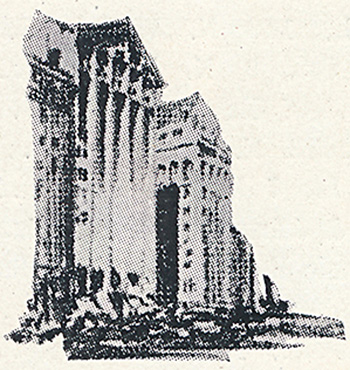
3) A small unidentified illustration.Date: 1926
Title: Charles L. Morgan Etching from a copper plate. Sailors on deck folding their nets.
Description: Charles L. Morgan (1890-1947) was an architect, and had a reputation as an excellent artist. Frank Lloyd Wright was working on the National Life Insurance Company project in 1924-1925. Wright sought Morgan's help in preparing a series of perspective drawings for the project. In 1925, an illustration or a home Morgan designed was exhibited at the Chicago Architectural Exhibition League. In 1926, the League awarded Morgan second place in the "Dickey" Architectural Competition. "During1926, Mr. Morgan made a flying trip to Europe, and during this short time in Spain, in France, and in England, he produced for The Western Architect an amazing series of sketches in pastel." From the foreword by Rexford Newcomb, A. I. A., "Color Sketches: Spain, France, England. A Series of Thirty Sketches Made by Mr. Morgan in a Trip to Europe." One of the thirty included with the Sketches, is an etching titled, "Barcelona Wharf." This etching is in the same style, but more complex. It is assume he drew many more drawings than just the thirty alone. This one may be been one of the many additional illustrations he created during his trip. An article in the October 10, 1926 Chicago Tribune announces an exhibit of Morgan's sketches of his trip in his studio in the Munroe Building in Chicago. (Note: This size, 8 x 10, matches an etching of "Barcelona Wharf.") "Barcelona Wharf" was chosen as one of the fifty best prints of 1926 by the Graphic Arts Society of New York. His sketches and portraits have been widely exhibited, many of them in the Smithsonian American Art Museum, the Art Institute of Chicago and galleries of other leading cities. Probably his greatest achievement was his work on the Powhatan Building in Chicago, competed in 1929. "Sailors on deck folding their nets" (Our Title.) 8 x 10 Etching from a copper plate, on paper, 10.75 x 13.5. Signed in pencil: To my dear "Mac" Charles Morgan 1926 (or 29). Matted and framed,
Size: 13.75 x 16.75.
S#: 0172.31.1016Date: 1926
Title: "Barcelona Wharf." Charles L. Morgan.
Description: Original Etching from a copper plate. Charles L. Morgan (1890-1947) was an architect, and had a reputation as an excellent artist. Frank Lloyd Wright was working on the National Life Insurance Company project in 1924-1925. Wright sought Morgan's help in preparing a series of perspective drawings for the project. In 1925, an illustration for a home Morgan designed was exhibited at the Chicago Architectural Exhibition League. In 1926, the League awarded Morgan second place in the "Dickey" Architectural Competition. "During 1926, Mr. Morgan made a flying trip to Europe, and during this short time in Spain, in France, and in England, he produced for The Western Architect an amazing series of sketches in pastel." From the foreword by Rexford Newcomb, A. I. A., "Color Sketches: Spain, France, England. A Series of Thirty Sketches Made by Mr. Morgan in a Trip to Europe." This etching was reproduced as one of the thirty prints in Color Sketches. An article in the October 10, 1926 Chicago Tribune announces an exhibit of Morgan's sketches of his trip in his studio in the Munroe Building in Chicago. "Barcelona Wharf" was chosen as one of the fifty best prints of 1926 by the Graphic Arts Society of New York. His sketches and portraits have been widely exhibited, many of them in the Smithsonian American Art Museum, the Art Institute of Chicago and galleries of other leading cities. Probably his greatest achievement was his work on the Powhatan Building in Chicago, completed in 1929. "Barcelona Wharf." Signed in pencil: "Barcelona Wharf Chas Morgan." Signed in plate: "CM 1926."
Size: Original 8 x 10 Etching from a copper plate, on paper 9.4 x 12 . Matted 12 x 15.
S#: 0172.39.0917Date: 1926
Bridge San Martin over Tajo River in Toledo, Spain, Courtesy of Mary Solio.
Title: Charles L. Morgan Original Pastel and Pencil. "Toledo, Spain."
Description: View of the Bridge San Martin over Tajo River in Toledo, Spain. Charles L. Morgan (1890-1947) was an architect, and had a reputation as an excellent artist. Frank Lloyd Wright was working on the National Life Insurance Company project in 1924-1925. Wright sought Morgan's help in preparing a series of perspective drawings for the project. In 1925, an illustration or a home Morgan designed was exhibited at the Chicago Architectural Exhibition League. In 1926, the League awarded Morgan second place in the "Dickey" Architectural Competition. "During 1926, Mr. Morgan made a flying trip to Europe, and during this short time in Spain, in France, and in England, he produced for The Western Architect an amazing series of sketches in pastel." From the foreword by Rexford Newcomb, A. I. A., "Color Sketches: Spain, France, England. A Series of Thirty Sketches Made by Mr. Morgan in a Trip to Europe." This is one of the original thirty illustrations used in the series, and is titled "Toledo, Spain." An article in the October 10, 1926 Chicago Tribune announces an exhibit of Morgan's sketches of his trip in his studio in the Munroe Building in Chicago. One of Morgan's greatest achievement was his work on the Powhatan Building in Chicago, competed in 1929.
Size: Original 10.75 x 13.25 Pastel and Pencil illustration.
S#: 0172.32.1016Date: 1927 Title: Color Sketches: Spain, France, England. A Series of Thirty Sketches Made by Mr. Morgan in a Trip to Europe. 1926. (Published by Western Architect, Chicago)
Author: Morgan, Charles L.; An Introduction by Newcomb, Rexford
Description: "A sketching trip through England, France and Spain with Charles L. Morgan! What could be more fascinating? ...Of the brilliancy, the fidelity, or the excellence of Mr. Morgan's work there is no necessity to write... Mr. Morgan possesses a talent in many respects the equal of the great English artist... But one naturally reverts to the truly remarkable results achieved by the artist n the limited time at his disposal..." (Introduction, May Day 1927). Wright was working on the National Life Insurance Company project in 1924-25 and sought Morgan out to prepare a series of perspective drawings of the design. During the destruction of Midway Gardens in 1929, Wright asked Morgan to assist him with an illustrated essay to be published in the Chicago Daily News. In 1930 Morgan cast sets of Wright's Nakoma and Nakomis. He later became an associate of Wright's in the early 1930s. Portfolio of 30 prints, 20 in color and 10 B&W. Portfolio is stiff paper covered in a dark red cloth printed front and back with gold ink. Portfolio forms pocket for prints. Four page insert. (First Edition) See our Wright study on the Nakoma Clubhouse & Sculptures.
Size: 8.75 x 11.75
Pages: Pp 4 +30
S#: 0198.08.1112
Color Sketches: Spain, France, England. A Series of Thirty Sketches Made by Mr. Morgan in a Trip to Europe. 1926. The bulk of the illustrations, thirteen, were illustrated in Toledo Spain.
Left: 1) "Entrance - To the ancient City of Toledo - CM 1926." Puerta de Bisagra, the 10th-century arched stone gate to the city of Toledo, dating from the era of Moorish rule. The road from Madrid leads to this gate on the North side of the ancient city of Toledo. A river flows around the South, East and West. There are two older bridges that cross the river. Puente de San Martin, San Martin's Bridge on the West and Puente de Alcantara, Alcantara Bridge on the East. Sheet: 8.5 x 11. (S#0198.08.1112-1)
Right: 2) "A Street in Toledo Spain. CM 1926." Sheet: 8.5 x 11. (S#0198.08.1112-2)Plate 4
Left: 3) "Toledo Spain. CM 1926." Sheet: 8.5 x 11. (S#0198.08.1112-3)Right: 4) "The Ancient City of Rock - Toledo Spain. CM 1926." Sheet: 8.5 x 11. (S#0198.08.1112-4)
Left: 5) "City of Rock, Toledo, Spain. Chas Morgan." View looking North toward the center of the city and the Santa Iglesia Catedral Primada of Toledo (Primate Cathedral of Saint Mary of Toledo) a Roman Catholic Cathedral. Sheet: 8.5 x 11. (S#0198.08.1112-5)
Right: 6) "Toledo, Spain. CM 1926." Signed lower right, within illustration: "Chas Morgan." Sheet: 8.5 x 11. (S#0198.08.1112-6)Plate 8
Left: 7) Unidentified illustration. Signed lower right, within illustration: "Chas Morgan." (Not indicated as Toledo, but the signature is consistent with others signed and illustrated in Toledo. Sheet: 8.5 x 11. (S#0198.08.1112-7)
Right: 8) "Typical Street, Toledo, Spain, 1926. Chas Morgan." In th background is the Santa Iglesia Catedral Primada of Toledo (Primate Cathedral of Saint Mary of Toledo) a Roman Catholic Church. Sheet: 8.5 x 11. (S#0198.08.1112-8)
Left: 9) Untitled. "Chas Morgan 1926." View of the San Martin Bridge over the Tajo River in Toledo, Spain, from the Southwest. This illustration was Published on the Title Page of the "Year Book of The Chicago Architectural Exhibition League and Catalogue of The Forty-First Annual Exhibition 1928. Sheet: 8.5 x 11. (S#0198.08.1112-9)Right: 10) "Toledo, Spain. CM 1926." View of the San Martin Bridge over the Tajo River in Toledo, Spain, from the South. (See Pastel) Sheet: 8.5 x 11. See original pastel...(S#0198.08.1112-10)
Left: 11) "A Street in Toledo. CM 1926." Signed lower right, within illustration: "Chas Morgan." Sheet: 8.5 x 11. (S#0198.08.1112-11)
Right: 12) "Toledo at noon.. CM 1926." Looking toward the center of Toledo from the South. The Cathedral of Saint Mary of Toledo is in the center of the old portion of town and can be seen in the background. Sheet: 8.5 x 11. (S#0198.08.1112-12)
Left: 13) "Alcantara Bridge - Toledo, Spain. CM 1926. View of the bridge from the West. Sheet: 8.5 x 11. (S#0198.08.1112-13)
Right: 14) "A Messenger in Spain." CM 1926." Sheet: 8.5 x 11. (S#0198.08.1112-14)
Left: 15) "Barcelona Wharf. Chas Morgan." Signed in plate: "CM 1926." (See original etching.) Sheet: 8.5 x 11. See original etching... (S#0198.08.1112-15)
Right: 16) "Wharf at Barcelona. CM 1926." Sheet: 8.5 x 11. (S#0198.08.1112-16)
Left: 17) "Barcelona. Chas Morgan 1926." Sheet: 8.5 x 11. (S#0198.08.1112-17)
Right: 18) "Notre Dame - Paris. CM 1926." Sheet: 8.5 x 11. (S#0198.08.1112-18)
Left: 19) "Paris Opera. CM 1926." Sheet: 8.5 x 11. (S#0198.08.1112-19)
Right: 20) "Memorial Flame in the Arch over grave of the unknown soldier. Paris. CM 1926." Sheet: 8.5 x 11. (S#0198.08.1112-20)
Left: 21) "Normandy, Shaggyfoot horses. CM 1926." Sheet: 8.5 x 11. (S#0198.08.1112-21)
Right: 22) "Wheat field full of Poppies, Normandy. CM 1926." Sheet: 8.5 x 11. (S#0198.08.1112-22)
Left: 23) "Yport, Normandy. CM 1926." (A small coastal community in Normandy, France.) Sheet: 8.5 x 11. (S#0198.08.1112-23)
Right: 24) "Ships at Cherbourg. CM 1926." (A shipping port on the Northern coast of France.) Sheet: 8.5 x 11. (S#0198.08.1112-24)
Left: 25) "Repair docks - Le Havre, France. CM 1926." (A shipping port on the Northern coast of France.) Sheet: 8.5 x 11. (S#0198.08.1112-25)
Right: 26) "Near Dieppe, France. Chas Morgan." Signed lower right, within the illustration. Sheet: 8.5 x 11. (S#0198.08.1112-26)
Left: 27) "L'E__font - Murke in Luxembourg - CM 1926." Sheet: 8.5 x 11. (S#0198.08.1112-27)
Right: 28) "Tower Bridge, London. Chas Morgan." Sheet: 8.5 x 11. (S#0198.08.1112-28)
Left: 29) "Horsham - 1926. Chas Morgan." (South of London.) Sheet: 8.5 x 11. (S#0198.08.1112-29)
Right: 30) "West Grimstead - England. CM 1926." Sheet: 8.5 x 11. (S#0198.08.1112-30)Date: 1927
Title: Charles Morgan Chalk-Talk Promotional Flyer 1927.
Author: Morgan, Charles L.
Description: Text on face: "A Modern Chalk-Talk Sketching for You.' Redpath Introduces Brilliant American Artist-Architect Charles Morgan AIA. Chicago Associate of Frank Lloyd Wright. Original - Entertaining - Instructive." Text on verso: "A Modern Chalk-Talk, Sketching for You. Charles Morgan, A. I. A., noted American artist, architect, Chicago associate of Frank Lloyd Wright, lecturer and entertainer takes the platform with a brilliant and original modern chalk-talk - Sketching for You. Sketching for You is a modern chalk-talk, and, therefore, different. In a simple, highly entertaining and graphic way, Charles Morgan deals with modern art, architecture and modern life. While producing his amazing sketches in color, which he does with miraculous speed, he makes his audience laugh with him as he separates the false from the true in art and in life. He shows the growth of architecture from ancient times. He explains what the trend in modern architecture is, and that there is a difference between modern and modernistic. He deals in principles and makes no compromise with truth. Sketching is such a joy to Charles Morgan that it is the most natural thing he does. In a flying trip to Europe, Mr. Morgan produced an amazing series of sketches in colors. His Barcelona Wharf was chosen as one of the fifty best prints of 1926 by the Graphic Arts Society of New York. His sketches and portraits have been widely exhibited, many of them in the Art Institute of Chicago and galleries of other leading cities..." There are also eight testimonials, one of which quotes Frank Lloyd Wright. " Frank Lloyd Wright, World Famous American Architect.” Not only are the fund a mental principles of all architecture given in a simple, entertaining and graphic way, but what we call Modern Architecture is explained and presented in extremely picturesque fashion. To make pictures with both hands and keep his audience laughing while giving sound instruction concerning a little understood element in our culture is no small achievement. Every educational institution really eager to educate its students should see and hear Charles Morgan's modern chalk-talk on architecture."
Size: 8 x 11
Pages: Pp 2
S#: 0198.23.0617Date: 1927
Title: The Western Architect - April 1927 (Digital Edition) (The Western Architect is published monthly by The Western Architect, Inc., Chicago)
Author: Morgan, Charles L.
Description: Plate 70. Text: "Mosaic Wall Panels for Avalon Theatre, Chicago. John Eberson, Architect.
Designed and Executed by Charles L. Morgan and Associates. Note: This is one of a series of imposing panels executed in the modern process perfected by the late Professor Newton A. Wells, of the University of Illinois, with whom Mr. Morgan was associated. It is quite the most important example of this process, made possible through co-operation of Mr. Eberson, the architect, and Mr. Morgan."
The Avalon Theater, a 2,500-seat auditorium opened on August 29, 1927. The Moorish Revival design includes many mosaic designs on the interior executed by Charles L. Morgan. Lobby photograph courtesy of Eric Allix Rogers. Detail photograph courtesy of Matthew Lambros and After the Final Curtain.
Size: 9 x 12
Pages: Plate 70
S#: 0199.07.1123
Plate 70. Text: "Mosaic Wall Panels for Avalon Theatre, Chicago. John Eberson, Architect. Designed and Executed by Charles L. Morgan and Associates. Note: This is one of a series of imposing panels executed in the modern process perfected by the late Professor Newton A. Wells, of the University of Illinois, with whom Mr. Morgan was associated. It is quite the most important example of this process, made possible through co-operation of Mr. Eberson, the architect, and Mr. Morgan."
The Avalon Theater, a 2,500-seat auditorium opened on August 29, 1927. The Moorish Revival design includes many mosaic designs on the interior executed by Charles L. Morgan. Lobby photograph courtesy of Eric Allix Rogers.
The Avalon Theater, a 2,500-seat auditorium opened on August 29, 1927. The Moorish Revival design includes many mosaic designs on the interior executed by Charles L. Morgan. Detail photograph courtesy of Matthew Lambros and After the Final Curtain.Date: 1927
Title: The Western Architect - June 1927 (The Western Architect is published monthly by The Western Architect, Inc., Chicago)
Author: Anonymous
Description: Book Report: Color Sketches in Spain, France, England, by Charles L. Morgan A.I.A.; Thirty sketches reproduced in color in portfolio form, with introduction by Rexford Newcomb, A.I.A.; Published by The Western Architect, Chicago; $7.50.
When Charles L. Morgan, known in Chicago for his work as a delineator, went abroad in the summer of 1926 on a month's sketching trip, he took with him unbounded enthusiasm for the subject, and an ability with which his friends have long been familiar, to capture in swift strokes, the charm of the subjects that interest him. From the large number of sketches in pastel, produced on this trip, thirty have been selected for reproduction the majority in full color. They are excellent examples of the printers’ art and plate making also. The original drawings have been faithfully reproduced.
In his introduction Mr. Newcomb compares the talent of Mr. Morgan to that of the great Brangwyn, whose admirer Mr. Morgan is, and to whom he showed his sketches during a visit to the great artist in England. The portfolio in which the sketches are contained, is designed, as well by Mr. Morgan, from Spanish motifs. It is a delightful part of the whole.
The author of these sketches is a firm believer in the art of sketching, and his contribution to the subject undoubtedly will inspire others to engage in this delightful and resultful avocation from which architects have been too much weaned.
See Additional Details...
Size: 9 x 12
Pages: Pp 102
S#: 0199.08.1123Date: 1927
Title: The Western Architect - July 1927 (Digital Copy) (The Western Architect is published monthly by The Western Architect, Inc., Chicago)
Author:: Morgan, Charles L.
DescriptionDescription: The Western Architect ran a series of articles titled “Color In Architecture” by Rexford Newcomb. Published within the article was this note on page 117: “Editor's Note - Beginning with this issue and throughout the series of Professor Newcomb's color articles, the color plates appearing each month will be rendered by Charles L. Morgan. This conforms with The Western Architect’s policy to give its readers the best there is. These renderings are wonderful examples of color application and modern architectural design - and we are quite sure Mr. Morgan needs no introduction as an architectural delineator.”
The color rending by Charles L Morgan is a two-page spread. On the proceeding and succeeding pages: “A Distinctive American Architecture. No. 7 of a series suggesting how color can be utilized to secure such distinction.”
Caption Plate 117-118: “ The Artistic Development of Color – in a Distinctive American Architecture. (Illustrating article on Color in Architecture by Rexford Newcomb, A. I. A.) A Rendering in Color by Charles L. Morgan. Courtesy the Terra Cotta Service Bureau, Chicago.”
SizeSize: 9 x 12
PagesPages: Plate 117-118
S#: 0199.09.1123
Caption Plate 117-118: “ The Artistic Development of Color – in a Distinctive American Architecture. (Illustrating article on Color in Architecture by Rexford Newcomb, A. I. A.) A Rendering in Color by Charles L. Morgan. Courtesy the Terra Cotta Service Bureau, Chicago.”Date: 1927
Title: The Western Architect - August 1927 (The Western Architect is published monthly by The Western Architect, Inc., Chicago)
Author: Morgan, Charles L.
Description: The Western Architect ran a series of articles titled “Color In Architecture” by Rexford Newcomb. Published within the July 1927 article was this note on page 117: “Editor's Note - Beginning with this issue and throughout the series of Professor Newcomb's color articles, the color plates appearing each month will be rendered by Charles L. Morgan. This conforms with The Western Architect’s policy to give its readers the best there is. These renderings are wonderful examples of color application and modern architectural design - and we are quite sure Mr. Morgan needs no introduction as an architectural delineator.”
The color rending by Charles L Morgan is a two-page spread. On the proceeding and succeeding pages: “A Distinctive American Architecture. No. 8 of a series suggesting how color can be utilized to secure such distinction.”
Caption Plate 135-136: “ The Artistic Development of Color – in a Distinctive American Architecture. (Illustrating article on Color in Architecture by Rexford Newcomb, A. I. A.) A Rendering in Color by Charles L. Morgan. Courtesy the Terra Cotta Service Bureau, Chicago.”
Size: 9 x 12
Pages: Plate 135-136
S#: 0199.10.1123
Caption Plate 135-136: “ The Artistic Development of Color – in a Distinctive American Architecture. (Illustrating article on Color in Architecture by Rexford Newcomb, A. I. A.) A Rendering in Color by Charles L. Morgan. Courtesy the Terra Cotta Service Bureau, Chicago.”Date: 1927
Title: The Western Architect - September 1927 (The Western Architect is published monthly by The Western Architect, Inc., Chicago)
Author: Morgan, Charles L.
Description: The Western Architect ran a series of articles titled “Color In Architecture” by Rexford Newcomb. Published within the July 1927 article was this note on page 117: “Editor's Note - Beginning with this issue and throughout the series of Professor Newcomb's color articles, the color plates appearing each month will be rendered by Charles L. Morgan. This conforms with The Western Architect’s policy to give its readers the best there is. These renderings are wonderful examples of color application and modern architectural design - and we are quite sure Mr. Morgan needs no introduction as an architectural delineator.”
The color rending by Charles L Morgan is a two-page spread. On the proceeding and succeeding pages: “A Distinctive American Architecture. No. 9 of a series suggesting how color can be utilized to secure such distinction.”
Caption Plate 153-154: “The Artistic Development of Color – in a Distinctive American Architecture. (Illustrating article on Color in Architecture by Rexford Newcomb, A. I. A.) A Rendering in Color by Charles L. Morgan. Courtesy the Terra Cotta Service Bureau, Chicago.”
Size: 9 x 12
Pages: Plate 153-154
S#: 0199.11.1123
Caption Plate 153-154: “The Artistic Development of Color – in a Distinctive American Architecture. (Illustrating article on Color in Architecture by Rexford Newcomb, A. I. A.) A Rendering in Color by Charles L. Morgan. Courtesy the Terra Cotta Service Bureau, Chicago.”Date: 1927
Title: The Western Architect - October 1927 (The Western Architect is published monthly by The Western Architect, Inc., Chicago)
Author: Morgan, Charles L.
Description: The Western Architect ran a series of articles titled “Color In Architecture” by Rexford Newcomb. Published within the July 1927 article was this note on page 117: “Editor's Note - Beginning with this issue and throughout the series of Professor Newcomb's color articles, the color plates appearing each month will be rendered by Charles L. Morgan. This conforms with The Western Architect’s policy to give its readers the best there is. These renderings are wonderful examples of color application and modern architectural design - and we are quite sure Mr. Morgan needs no introduction as an architectural delineator.”
The color rending by Charles L Morgan is a two-page spread. On the proceeding and succeeding pages: “A Distinctive American Architecture. No. 10 of a series suggesting how color can be utilized to secure such distinction.”
Caption Plate 171-172: “The Artistic Development of Color – in a Distinctive American Architecture. (Illustrating article on Color in Architecture by Rexford Newcomb, A. I. A.) A Rendering in Color by Charles L. Morgan. Courtesy the Terra Cotta Service Bureau, Chicago.”
Size: 9 x 12
Pages: Plate 171-172
S#: 0199.12.1123
Caption Plate 171-172: “The Artistic Development of Color – in a Distinctive American Architecture. (Illustrating article on Color in Architecture by Rexford Newcomb, A. I. A.) A Rendering in Color by Charles L. Morgan. Courtesy the Terra Cotta Service Bureau, Chicago.”Date: 1927
Title: The Western Architect - November 1927 (Digital Copy) (The Western Architect is published monthly by The Western Architect, Inc., Chicago)
Author:: Morgan, Charles L.
Description: The Western Architect ran a series of articles titled “Color In Architecture” by Rexford Newcomb. Published within the July 1927 article was this note on page 117: “Editor's Note - Beginning with this issue and throughout the series of Professor Newcomb's color articles, the color plates appearing each month will be rendered by Charles L. Morgan. This conforms with The Western Architect’s policy to give its readers the best there is. These renderings are wonderful examples of color application and modern architectural design - and we are quite sure Mr. Morgan needs no introduction as an architectural delineator.”
The color rending by Charles L Morgan is a two-page spread. On the proceeding and succeeding pages: “A Distinctive American Architecture. No. 11 of a series suggesting how color can be utilized to secure such distinction.”
Caption Plate 189-190: “The Artistic Development of Color – in a Distinctive American Architecture. (Illustrating article on Color in Architecture by Rexford Newcomb, A. I. A.) A Rendering in Color by Charles L. Morgan. Courtesy the Terra Cotta Service Bureau, Chicago.”
Size: 9 x 12
Pages: Plate 189-190
S#: 0199.13.1123
Caption Plate 189-190: “The Artistic Development of Color – in a Distinctive American Architecture. (Illustrating article on Color in Architecture by Rexford Newcomb, A. I. A.) A Rendering in Color by Charles L. Morgan. Courtesy the Terra Cotta Service Bureau, Chicago.”Date: 1927
Title: The Western Architect - December 1927 (Digital Copy) (The Western Architect is published monthly by The Western Architect, Inc., Chicago)
Author: Morgan, Charles L.
Description: The Western Architect ran a series of articles titled “Color In Architecture” by Rexford Newcomb. Published within the July 1927 article was this note on page 117: “Editor's Note - Beginning with this issue and throughout the series of Professor Newcomb's color articles, the color plates appearing each month will be rendered by Charles L. Morgan. This conforms with The Western Architect’s policy to give its readers the best there is. These renderings are wonderful examples of color application and modern architectural design - and we are quite sure Mr. Morgan needs no introduction as an architectural delineator.”
The color rending by Charles L Morgan is a two-page spread. On the proceeding and succeeding pages: “A Distinctive American Architecture. No. 12 of a series suggesting how color can be utilized to secure such distinction.”
Caption Plate 207-208: “The Artistic Development of Color – in a Distinctive American Architecture. (Illustrating article on Color in Architecture by Rexford Newcomb, A. I. A.) A Rendering in Color by Charles L. Morgan. Courtesy the Terra Cotta Service Bureau, Chicago.” Note: Digital copy missing Plate 207-208.
Size: 9 x 12
Pages: Plate 207-208
S#: 0199.14.1123Date: 19288
TitleTitle: Chicago Architectural Exhibition. Alcantara Bridge, Toledo, Spain. Illustrated by Charles L. Morgan, 1928.
Description: One of the illustrations (#9) from "Color Sketches: Spain, France, England. A Series of Thirty Sketches Made by Mr. Morgan in a Trip to Europe. 1926." Published on the Title Page of the "Year Book of The Chicago Architectural Exhibition League and Catalogue of The Forty-First Annual Exhibition 1928. East Galleries, The Art Institute of Chicago. May Nineteenth to June Seventh. Text: "Alcantara Bridge, Toledo, Spain. By Charles L. Morgan, Chicago." Courtesy of the Art Institute of Chicago.
Size: 8 x 10 B&W photograph.
S#: 0215.23.0219Date: 1928
Title: The Powhatan Building. Illustrated by Charles L. Morgan, 1928.
Description: The Powhatan or Powhatan Apartments is a 22-story apartment building overlooking Lake Michigan. The building was designed by architects Robert De Golyer and Charles L. Morgan. Morgan was responsible for the colorful mosaics in the lobbies and ballroom, as well as the colorful exterior terra-cotta panels featuring scenes with Native American references. Other American Indian motifs can be found throughout the building. Signed bottom right: "C. Morgan." Text: "The Powhatan." Courtesy of the Art Institute of Chicago.
Size: 6.5 x 10 B&W photograph.
S#: 0215.24.0319Date: 1928
Title: The Western Architect - January 1928 (Published monthly by The Western Architect, Inc., Minneapolis, Minnesota) (Incomplete copy.)
Author: Morgan, Charles L.; McLean, Robert Craig
Description: Page 4-8: Test on page 4: "Of interest: Beginning with this issue a regular monthly feature in the Western Architect will be the appearance of groups of sketches by some of the most outstanding architects and artists in the profession. In this issue we have presented four from the folio of Charles L Morgan. These are taken from the large group of sketches he made on his trip through Europe or year or so ago." Robert Craig McLean. Page 5: "Barcelona Wharf. From the original etching by Charles L. Morgan, A. I. A." (1926). Pages 6-8: Three selections from "Color Sketches: Spain, France, England. A Series of Thirty Sketches Made by Mr. Morgan in a Trip to Europe. 1926." Thirty sketches and folder published by Western Architect, Chicago, 1928. Page 6: "Toledo, Spain. From the original sketch by Charles L. Morgan, A. I. A." (1926). Original Pastel and Pencil, Plate 10. Page 7: "Typical Street, Toledo, Spain. From the original sketch by Charles L. Morgan, A. I. A." (1926). Plate 8. Page 8: "The Ancient City of Rock, Toledo Spain. From the original sketch by Charles L. Morgan, A. I. A." (1926). Plate 4. Plates 9-10: "Skyscraper Bridge with 25 story buildings as center pylons and beautiful rainbow color affect across of mile long span. A distinctive American Architecture to which terra-cotta is readily adaptable. A rendering in Color by Charles L Morgan. Courtesy the Terra-cotta Service Bureau, Chicago. (Illustrating article on Color in Architecture by Rexford Newcomb, A. I. A.)" Original cover price 50c.
Size: 9 x 12
Pages: Pp 5-8, Plate 9-10
S#: 0215.25.0319Plates 9-10
Plates 9-10: "Skyscraper Bridge with 25 story buildings as center pylons and beautiful rainbow color affect across of mile long span. A distinctive American Architecture to which terra-cotta is readily adaptable. A rendering in Color by Charles L Morgan. Courtesy the Terra-cotta Service Bureau, Chicago. (Illustrating article on Color in Architecture by Rexford Newcomb, A. I. A.)"Date: 1928
Title: Rainbow Bridge Illustrated by Charles L Morgan,1928.
Description: Offers Rainbow Span of Towers to Unite Parks. Artist for Bridge Pier. Skyscrapers Rainbow Bridge Suggested For Outer Drive. Published in the Chicago Tribune, January 15, 1928. By Al Chase.
Rainbow bridge, a huge arched army of skyscrapers in a single row, bending in a sweeping band of color from Lake Shore drive to Randolph street, is the suggested method of linking north and south sides near the mouth of the river, made by Charles Morgan, Chicago artist and architect. The location and application of the proJect to the city s development is being made by D. H. Burnham & Co.
Would Be Full of Color. The name of the great proposed Rainbow bridge, is given because of the sweeping bands of color suggested by Mr. Morgan which would result in a rainbow effect when seen from the lake or viewed from Michigan avenue.
The startling novelty in Mr. Morgan’s project is the utilization of the great piers as office building skyscrapers of twenty-five or more stories. Still more would be the entrance into these unique structures—from the top. The tenants would whiz over the bridge to the pier which contained their respective building, park their cars in the proposed garage in the upper floors, and drop down in an elevator to their offices.
A width of approximately 150 feet is suggested for the bridge by the architects. The grade would be about 8 per cent.
Offers World Feature. “Rainbow bridge, if carried out on the scale suggested, would make one of the world’s most imposing structures,” said Herbert Burnham of D. H. Burnham & Co.
“It would give Chicago’s water front one of the most novel and interesting developments of any great metropolis,” said Mr. Morgan. “It would mean the linking the north and south side boulevard systems with a monumental rainbow hued causeway, unlike anything to be found in the world, I believe.”
The project will be submitted to James Simpson, head of the Chicago plan commission, and to the heads of the Lincoln and south park boards.
Two B&W photogsa of the illustrations published in the Chicago Tribune January 15, 1928. Courtesy of the Chicago Tribune.
Size: 10 x 4.5 and 5.25 x 9.75 B&W photographs.
S#: 0215.51.0126, 0215.52.0126
Left: Caption: Location of proposed Rainbow bridge for the outer drive1, as suggested by D. H. Burnham & Co., would be from Lake Shore drive, crossing the river somewhere near its mouth, to Randolph street extended. Bands of colored terra cotta would give it a rainbow effect. Above is a sketch of the proposed bridge.
Caption: Photograph of etching made
by Charles L. Morgan, showing his
suggested used of Rainbow bridge
piers as skyscrapers. The widest
opening is over the Chicago river,
with boat passing under bridge.
A Skyscraper Bridge Proposed for Chicago. A monumental skyscraper bridge has been proposed to span the mouth of the Chicago River linking the north and south boulevards. The scheme presented here was conceived by Charles L. Morgan and accomplished a novel combination of bridge and skyscraper construction. The bridge would be carried a loft on skyscraper appears twenty-five or more stories in height. These peers would afford valuable office space which would be rented at a considerable profit. The bridge spans would be so high above the river as to permit unobstructed river traffic. The alternate arches between the skyscrapers would span the streets and alleys, with the central arch of greater width crossing the river.
Chas Morgan Del. The proposed skyscraper bridge, Chicago. D. H. Burnhan and Co., Architects.Date: 1929
Title: 'Detroit" by Charles L. Morgan
Description: Tall ships in the Detroit Harbor. Signed: "Detroit. Charles Mogan 1929." .Date: 1929-30
Title: Nakoma Glazed Terra-cotta Sculpture, 1929-30.
Description: Black glazed terra-cotta Nakoma sculpture by Charles L. Morgan. Terra-cotta Nakoma and Nakomis sets were created in 1929-1930 by Charles L. Morgan from models created by Frank Lloyd Wright.
In 1923 Wright was commissioned to design a clubhouse for the Nakoma Golf Club, Madison, Wisc. In 1924 he was commissioned to design the Memorial Gateway to the Nakoma subdivision, which at the time was on the outskirts of Madison. Wright’s plans were well received by the Madison Realty Company. Wright designed the 18 foot Nakomis and a 16 foot Nakoma in 1923-24 for the Nakoma Memorial Gateway project. Models were created by Wright and were photographed on August 3, 1926 at Taliesin, Spring Green, Wisconsin. The project was rejected due to the cost. Wright refused to scale down the plans, and the Gateway project was abandoned.
The Powhatan Building was designed by architects Robert De Golyer and Charles L. Morgan, and completed in 1929. Morgan was responsible for the colorful mosaics in the lobbies and ballroom, as well as the colorful exterior terra-cotta panels featuring scenes with Native American references as well as other American Indian motifs finished with a black glaze.
With the completion of the Powhatan Building in 1929, Morgan’s association with Wright, and American Indian motifs and terra-cotta molds freshly on Morgan's mind, his involvement in the Nakoma and Nakomis sets was a natural fit. In a letter to Wright dated December 23, 1930, Morgan discussed finishing the chief and squaw statues in time for Christmas, "and after all these weeks I am having to keep at it all the time to get a few black sets..." It was possibly the same black glaze used on the Indian chiefs on the Powhatan Building.
Inscribed on the lower back side: “FLLW” within a square. After glazing, the impression of the square remains, but not the “FLLW”.
Size: 11.75" tall, 4" wide, 5.75" deep.”
ST#: 0228.43.1125Date: 1933
Title: Charles L. Morgan Etching, “Hall of Science, Chicago Fair,” 1933.
Description: Photographic copy of a drypoint print “Hall of Science, Chicago Fair.” Signed lower left in pencil on original print: "Hall of Science." Signed lower right in pencil on original print: “Charles Morgan 1933.” Courtesy of the Smithsonian American Art Museum.
Size: Original dimension: 10.75 x 14. 8 x 10 Color photograph.
ST#: 0370.21.1123Date: 1933
Title: Charles L. Morgan Etching, “Chicago Fair,” 1933.
Description: Photographic copy of a drypoint print “Chicago Fair.” Signed lower left in pencil on original print: "1833-1933." Signed lower right in pencil on original print: “Charles Morgan 1933.” Courtesy of the Smithsonian American Art Museum.
Size: Original dimension: 10.8 x 11. 8 x 8.5 Color photograph.
ST#: 0370.22.1123Date: 1933
Title: Charles L. Morgan Etching, “Peace - In a Storm - Flanders,” 1933.
Description: Photographic copy of an etching on paper “Peace - In a Storm - Flanders.” Courtesy of the Smithsonian American Art Museum.
Size: Original dimension: 17.75 x 12.25. 10 x 7.5 Color photograph.
ST#: 0370.23.1123Date: 1933
Title: Charles L. Morgan Etching, “A Glimpse of Belgium,” 1933.
Description: Photographic copy of a drypoint print “A Glimpse of Belgium.” Signed lower left in pencil on original print: "A Glimpse of Belgium." Signed lower right in pencil on original print: “Charles Morgan 1933.” Courtesy of the Smithsonian American Art Museum.
Size: Original dimension: 10.8 x 14. 8 x 10 Color photograph.
ST#: 0370.24.1123Date: 1933
Title: Charles L. Morgan Etching, “Arcturus Lights The Fair,” 1933.
Description: Photographic copy of a mezzotint print “Arcturus Lights The Fair.” Signed lower left in pencil on original print: "Arcturus Lights The Fair." Signed lower right in pencil on original print: “Charles Morgan 1933.” Courtesy of the Smithsonian American Art Museum.
Size: Original dimension: 14 x 10.5. 8 x 10 Color photograph.
ST#: 0370.25.1123Date: 1947
Title: Charles L. Morgan Obituary 1947. Obituary for Charles Leonard Morgan published in the Evening Independent, St. Petersburg, Florida, Monday, April 7, 1947.
Description: "Charles Morgan, Famous Architect, Drowns at Richey. Tarpon Springs - Charles Leonard Morgan, 56, world renowned architect and designer, was accidentally drowned in the Cootee River at New Port Richey early Saturday afternoon. Mr. Morgan, a great humanitarian and lover of children, had gone into the river in a small rowboat to get a ball for some children who were playing along the shore and had tossed the ball into the water... A graduate of the class of 1913, University of Illinois, Mr. Morgan, architect and artist, was a former professor of architecture at Kansas University, and professor of architecture and designing at Florida Southern College, Lakeland. He had recently completed a three-year architectural tour of the leading cities in South America... Mr. Morgan was an associate architect with the firm of Frank Lloyd Wright, of Chicago, with connections in New York, St. Louis, and several other large cities in the United States..."
Size: 4 x 5 B&W photograph.
S#: 0720.38.0720Date: 1929 (Photographed in 2014)
Title: Powhatan Building completed in 1929, photographed in 2014.
Description: The Powhatan or Powhatan Apartments is a 22-story apartment building overlooking Lake Michigan. The building was designed by architects Robert De Golyer and Charles L. Morgan. Morgan was responsible for the colorful mosaics in the lobbies and ballroom, as well as the colorful exterior terra-cotta panels featuring scenes with Native American references. Other American Indian motifs can be found throughout the building. Of particular interest are the mosaic panels in the anteroom between the lobby and the pool. They bear a striking resemblance to the murals in the Tavern of Midway Gardens, designed by Wright in 1913. It's possible Morgan wished to honor Wright's work at the Midway Gardens, which was demolished at the same time the Powhattan Building was receiving its final touches. During the destruction of Midway Gardens, Wright asked Morgan to assist him with an illustrated essay on Midway Gardens that was planned but never published in the Chicago Daily News. With the completion of the Powhatan Building in 1929, Wright's association in December, and American Indian motifs and terra-cotta molds freshly on Morgan's mind, his involvement in the Nakoma and Nakomis sets was a natural fit. In a letter to Wright dated December 23, 1930, Morgan discussed finishing the chief and squaw statues in time for Christmas, "and after all these weeks I am having to keep at it all the time to get a few black sets..." It was possibly the same black glaze used on the Indian chiefs on the Powhatan Building. Photographed on a trip to Chicago on January 9, 2014.
ST#: 2014.39.1117 (1-11)
1) Left: Powhatan Building. 13 x 20 High Res digital photograph. (ST#2014.39.1117-1)
2) Left: Powhatan Building. 15 x 20 High Res digital photograph. (ST#2014.39.1117-2)
3) Right: Powhatan Building. Morgan was responsible for the colorful mosaics in the lobbies and ballroom, as well as the colorful exterior terra-cotta panels featuring scenes with Native American references. 15 x 12 High Res digital photograph. (ST#2014.39.1117-3)
3A & 3B) Powhatan Building. Two examples of the colorful exterior terra-cotta panels featuring scenes with Native American references. (ST#2014.39.1117-3A & B)
3C & 3D) Powhatan Building. Two examples of the colorful exterior terra-cotta panels featuring scenes with Native American references. (ST#2014.39.1117-3C & D)
3E & 3F) Powhatan Building. Two examples of the colorful exterior terra-cotta panels featuring scenes with Native American references. (ST#2014.39.1117-3E & F)
4) Left: Powhatan Building. Examples of the black glazed terra-cotta panels decorating the lower levels of the building. 15 x 20 High Res digital photograph. (ST#2014.39.1117-4)
5) Right: Powhatan Building. Example of a black glazed terra-cotta panel decorating the lower levels of the building. 15 x 20 High Res digital photograph. (ST#2014.39.1117-5)
6) Left: Powhatan Building. Example of a black glazed terra-cotta panel decorating the lower levels of the building. 15 x 20 High Res digital photograph. (ST#2014.39.1117-6)
7) Right: Powhatan Building. The overhang over the entrance is buttressed by two Indian sculptures. 15 x 20 High Res digital photograph. (ST#2014.39.1117-7)
8) Left: Powhatan Building. Detail of the Indian sculpture buttressing the entrance overhang. Morgan finished a few sets of Nakoma and Nakomis in a black glaze. 15 x 20 High Res digital photograph. (ST#2014.39.1117-8)
9) Right: Powhatan Building. Detail of the Indian sculpture buttressing the entrance overhang. Morgan finished a few sets of Nakoma and Nakomis in a black glaze. 15 x 20 High Res digital photograph. (ST#2014.39.1117-9)
10 & 11) Left and Right: Powhatan Building. Mosaic panels in the anteroom between the lobby and the pool of the Powhatan Building. As the Powhatan was receiving its final touches in 1929, the Midway Gardens was demolished in October 1929. The similarities between the Midway Gardens' murals and Morgan's mosaic panels are striking. Possibly his homage to Wright and the Midway Gardens.. 15 x 20 High Res digital photographs. (ST#2014.39.1117-10 & 11)Date: 1929
Title: Liberty Magazine Covers Morgan Mosaic (1929). Triangles in Color / September.
Description: In 1929, Charles L. Morgan created a number of Mosaics based on the Liberty Cover design "September Desert" by Frank Lloyd Wright. Original mosaic is painted ceramic tiles, 26.75" x 25" x .5." Published in Frank Lloyd Wright, Graphic Artist, Fowler, 2002, p.96. Courtesy of The Museum of Modern Art MOMA.
Size: 8 x 9 Color Photograph.
S#: 0228.35.0620Date: 1930
Title: Chicago Tribune - September 28, 1930 (Published daily by the Chicago Tribune Inc. Chicago)
Author: Jewett, Eleanor
Description: 'Frank Lloyd Wright Talks of Particular interest to Those with Architectural Leanings; New Exhibits Announced Daily as Fall Seasons Gets Under Way. In all probability the most significant event of this week will be the lectures to be given by Frank Lloyd Wright on Wednesday at the Art Institute. The Wednesday lecture is to be addressed primarily to the young men in architecture. Mr. Wright will speak on 'The New Architecture' at 2:39 o'clock in Fullerton hall. He is well qualified to discuss his subject from... The second of Mr. Wright's lectures will be given Thursday evening at 8 o'clock in the Goodman theater. Admission to the lecture is by ticket, but without charge. Tickets may be obtained at the desk in the main lobby of the art institute, Mr. Wright will speak on 'In The Realm of Ideas.' - In conjunction with the lectures there is now current in the Art institute an exhibit of architectural designs and models by Frank Lloyd Wright which will continue to Oct. 12." "Charles L. Morgan is having an exhibit of lithographs, etchings and pastels in the Kroch gallery. A magnificent rendering of Frank Lloyd Wright's glass office building, a New York achievement discussed at length in architectural and intellectual circles, is of interest. Mr. Morgan is himself an architect as well as an etcher and painter and he is a devoted follower of Mr. Wright. The exhibition is well worth while."
Size: 5 x 10.5 clipping
Pages: Section 8, p.6
S#: 0249.45.0417Date: 1934
Title: Dutch Village. Illustrated by Charles L. Morgan, 1934.
Description: Aerial perspective of the Dutch Village at the Century of Progress International Exposition. The Century of Progress International Exposition was a World's Fair held in Chicago, as The Chicago World's Fair, from 1933 to 1934. The Dutch Village was designed by Burnham Brothers and Hammond Architects. Signed bottom right: "C. Morgan." Text: "Dutch Village. A Century of Progress 1934. Burnham Brothers and Hammond Architects." Courtesy of the Art Institute of Chicago.
Size: 10 x 7 B&W photograph.
S#: 0376.02.0319Date: 2001
Title: A Guide to Chicago's Murals (Published by The University of Chicago Press, Chicago and London)
Author: Gray, Mary Lackritz
Description: Back cover: "Chicago is a city known for its fabulous architecture and public sculpture by artists such as Picasso and Calder, but anyone who has seen the gorgeous lunettes in the Auditorium Theater or the South Side's Wall of Respect, which inaugurated the city's contemporary mural movement, knows that Chicago has an equally rich tradition of mural painting. Through these murals, the history of Chicago and the nation is writ in churches and lobbies, on viaducts and school walls. Mary Gray's A Guide to Chicago's Murals is the first definitive handbook to the treasures that can be found all over the city." Includes a section of Charles L. Morgan and the Powhatan Building, p.172-173. Also includes a biography, p. 441. (First Edition)
Size: 6 x 7.75
Pages: Pp 488
ST#: 2001.85.0321Date: 2004
Title: National Register of Historic Places, Narragansett (Published by the United States Department of the Interior, National Park Service, Washington D. C. Service)
Author: Tatum, Terry
Description: (Note: Excellent biography on Charles L. Morgan.) Excerpts: Charles L. Morgan, Artist and Architect. The terra cotta panels that appear on the primary facades of the Narragansett were designed by Charles L. Morgan, who was recognized both as an artist and architect. Charles Leonard Morgan (b. October 13, 1890, Mount Vernon, IL - d. April 5, 1947, Port Richey, FL) was an architect that is best known for his color artistry in his architectural renderings and for his perspective etchings. Although he began his studies at the University of Illinois in electrical engineering, he later transferred into the architecture program, receiving a B.A. in architecture in 1914. He began his career with the architectural firm of Davidson, Lockwood & Morgan, and shortly thereafter opened his office as a freelance artist, mainly producing architectural renderings. In 1918 he began teaching free hand drawing at the University of Illinois. Perhaps Charles Morgan enjoyed teaching, for throughout his career he held positions at institutions such as Kansas State University in Manhattan, KS (Associate Professor of Architecture, 1934- 37), University of Kansas (Associate Professor of Aeronautics, 1943), and later in Florida and South America. Morgan was a member of the American Institute of Architects, the Illinois Society of Architects, the Architects Club of Chicago, the Architectural Sketch Club, and the Chicago Society of Etchers.
Beginning in the 1920s, Charles Morgan touted himself as a specialist in the development of modern architecture. As an expert in architectural rendering, he was asked in 1927 to contribute color plates for a series of monthly articles in Western Architect designed to stimulate interest in polychromy as applied to architecture. The color plates accompanied articles by Rexford Newcomb, A.I.A., and appeared courtesy of the Terra Cotta Service Bureau of Chicago. The Terra Cotta Service Bureau was an organization maintained by the major American manufacturers of terra cotta including Chicago's American Terra Cotta & Ceramic Company, Midland Terra Cotta Company, and the Northwestern Terra Cotta Company to promote the use of terra cotta in architecture. Morgan's color renderings were a significant marketing tool for the terra cotta companies to sell polychrome ornament for use on walls and trim of buildings built in the late 1920s. Perhaps Charles Morgan's associations with the Terra Cotta Service Bureau led to his commissions with the Powhatan Apartments in conjunction with architect Charles DeGolyer in 1927 and for the Narragansett Apartments in conjunction with architects Leichenko and Esser in 1928. The designs for the Powhatan, done a year earlier than the Narragansett, are notable for Morgan's extraordinary and prolific use of color and the highly original images found on the terra cotta panels. 16 Both buildings share Native American names, as well as exhibit ornament that was inspired by Native American images of the 1910s and 1920s.
Morgan's low relief sculptural terra cotta panels on the Narragansett are original imaginative interpretations of recognizable themes. They fit squarely within the tradition of ornamentation that expressed traditional images in a stylized manner. This follows a long line of representational sculpture in Chicago architecture originating so eloquently with Louis Sullivan. Here in the Narragansett, the Native American-inspired designs are stylized consistent with Art Deco sensibility. Morgan's polychrome panels seem to be a more innovative visual statement in architecture. Although the designs are reflective of the Abstract Expressionist movement whose roots were in Germany but rose to prominence in New York from the 1920s, the use of painted panels of this type is unusual on a building. Rather than sculpture, these panels appear as colorful paintings up the sides of the structure. The three different designs are mixed in arrangement on the two facades of the structure, making it difficult at first to determine just how many unique designs there are. By combining his artistic and architectural talents, Morgan was able to collaborate with Leichenko and Esser to successfully unite original decorative art, through the use of architectural terra cotta, with skyscraper design of the 1920s.
Charles Morgan continued collaborative efforts with Leichenko and Esser with the National Tea Company Store at 2341-43 W. Devon Avenue in Chicago, IL, a remodeling and expansion of a 40x68 foot building to a 40x125 building once occupied by the former North Town State Bank.
Charles Morgan had established relationships with other architects including Frank Lloyd Wright. In 1931, Frank Lloyd Wright's drawings for the cover of Liberty Magazine appeared with a set of mosaics by Charles L. Morgan depicting his designs in an exhibition in Europe. Not much else is known about their relationship. Morgan also exhibited his watercolors, lithographs, etchings, pastels, and renderings at the Kroch Gallery in late 1930. Included in this exhibit was a portrait of Frank Lloyd Wright.
Other projects by Morgan include working as an associate architect with Alex Capraro for the Italian Building at the Century of Progress Exposition in 1933; as associate architect for the Bahai Temple in Wilmette, IL (he was a member of the Bahai faith); Rainbow Bridge, a whimsical design with rainbow colors and skyscraper piers that was proposed by D.H. Bumham & Company for Chicago's Outer Drive and never built; and an "igloo garden house," a small storage out building built with concrete and metal lath in the shape of an igloo that he hoped would be mass-produced. In later years, he worked on many projects in South America, continued teaching, and returned to Chicago in the mid-1 940s. He was decorated with the Chevalier of the Crown of Italy in 1934 and the author of a 1927 book Color Sketches, Spain, France and England produced by the Western Architect. Architectural artist Charles Morgan died in a drowning accident while vacationing in Port Richey, FL on April 5, 1947. He was 56 years old.
Size: 8.5 x 11
Pages: Pp 58
ST#: 2004.82.1117CHICAGO ART DECO SOCIETY Date: 2005 Title: Chicago Art Deco Society - Fall 2005 / Winter 2006 (Published by the Chicago Art Deco Society, Chicago)
Author: Harris, Neil; Edelstein, Teri J.
Description: "The Powhatan, an impressive expression of deco design, even for the high-flying twenties... An associate architect was appointed to handle the exterior and interior appointments. This was Charles L. Morgan, an avowed modernist, a prominent architectural renderer (his depictions of new buildings were featured, on an almost weekly basis, by the Chicago Tribute in this period), and an associate of Frank Lloyd Wright. Morgan had lectured in Evanston for the Taliesin fellowship, and Wright had great confidence in him...) Of particular interest are the terra-cotta panels and black Indian sculptures of The Powhatan, completed in 1929. Morgan was involved with Frank Lloyd Wright during this time period, producing terra-cotta Nakoma and Nakomis sets, some produced with a black glaze, similar to those he produced for The Powhatan. For more information see our Wright Study on the Nakoma Clubhouse. Includes 26 photographs. Original Cover Price $4.00. See our Wright study on the Nakoma Clubhouse & Sculptures.
Size: 8.5 x 11
Pages: Pp Cover 13-20
ST#: 2005.35.0114
Additional Wright Studies SEE ADDITIONAL WRIGHT STUDIES Frank Lloyd Wright's First Published Article (1898) Photographic Chronology of Frank Lloyd Wright Portraits
"Frank Lloyd Wright's Nakoma Clubhouse & Sculptures." A comprehensive study of Wright's Nakoma Clubhouse and the Nakoma and Nakomis Sculptures. Now Available. Limited Edition. More information.
HOME ARTIFACTS AUDIO BOOKS PERIODICALS PHOTOS POSTCARDS POSTERS STAMPS STUDIES ASSISTING ABOUT SLIDE SHOW To donate or pass on information, comments or questions:
steinerag@msn.com
©Copyright Douglas M. Steiner, 2001, 2026



